Gallipoli | A Tale Of Two Cities Entwined in the Current of Tide and Time
The Greek influence on Puglia’s Salento peninsula is ever present. Road signs tell us we have arrived in “Magna Grecia” – greater Greece. There are directional signs to follow to Greece (via the Brindisi ferries). Griko, a dialect that can be traced back to classic Greek origins, is still spoken in the villages south of Lecce, particularly those around Otranto on the Adriatic coast to Gallipoli on the Ionian, where Greek cultural identity was at its strongest.
Spanning time and tide, Gallipoli’s name reveals its Greek origins: kalé pólis (“beautiful town”), the ancient name given to the fishing village and port that comprise the old town. At the heart of Gallipoli’s narrative stands another bridge – a physical connection uniting two worlds, connecting the old and the new, the quiet and the vibrant.
On one side of the 16th century Ponte Città Vecchia old town bridge perched on a limestone island jutting into the Ionian Sea, Gallipoli’s old town whispers stories of a centuries old fishing village insulated by its ancient city walls. On the other modern Gallipoli radiates a different energy. A hub of contemporary life, brimming with vibrant shops, bustling piazzas, and a thriving cultural scene.
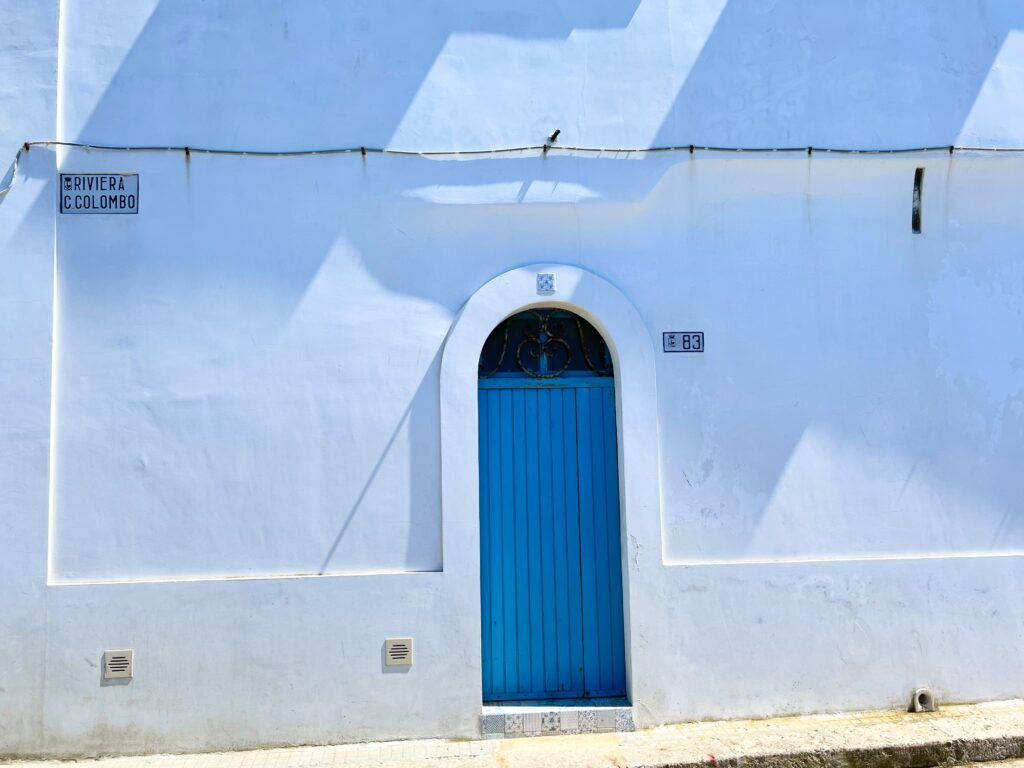
But tide and time wait for no one and these days Gallipoli’s charismatic split personality spills over into the old town. By day its fishermen residents sit in cool shade forged out of sun-soaked alleys lined by whitewashed facades, to chat, drink and mend their nets, living out a past history. It seems as if modern life has failed to intrude upon them. But as the sun dips below the horizon, Gallipoli’s transformation is undeniable. During the summer season it undergoes a metamorphosis, transforming into a pulsating party mecca.
From Whispers to Roars | Gallipoli Unleashed
Gallipoli has become a hotspot for travellers seeking both history and hedonism. The summer season sees a seismic shift as Gallipoli becomes synonymous with revelry and celebrations extending well beyond the old and new towns. Nearby beaches – especially those in and around Baia Verde – echo with the rhythms of music festivals, vibrant parties, and a diverse crowd. Beach clubs, bars, and open-air discos pulse with energy, their neon lights casting kaleidoscopic reflections on the waters. International DJs spin tunes that resonate with the waves, as revelers from around the world unite to dance beneath the stars.
A Stroll Through Time | Our Gallipoli To Do List
Gallipoli is not merely a seaside town—it is in the sea, an island-city with a deep historical legacy and a distinctive urban identity.
The old town stands testament to the town’s deep-rooted history. With each step nearer its heart it’s as if you’ve stepped back in time. The narrow winding streets, lined with pastel-coloured buildings adorned with vibrant flowers, create a postcard-worthy scene. The best way to explore Gallipoli’s old town is to wander the narrow streets, alleyways and courtyards. Don’t worry, you won’t get lost in its nooks and crannies, even if you momentarily loose your bearings. You always come back to the sea!
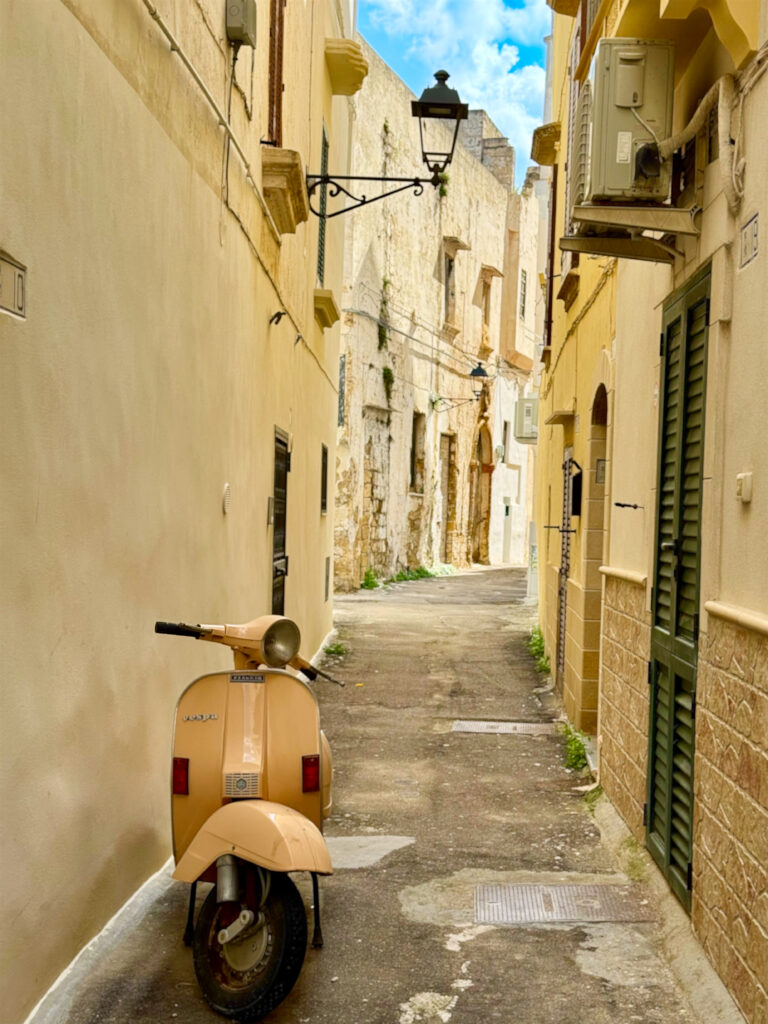
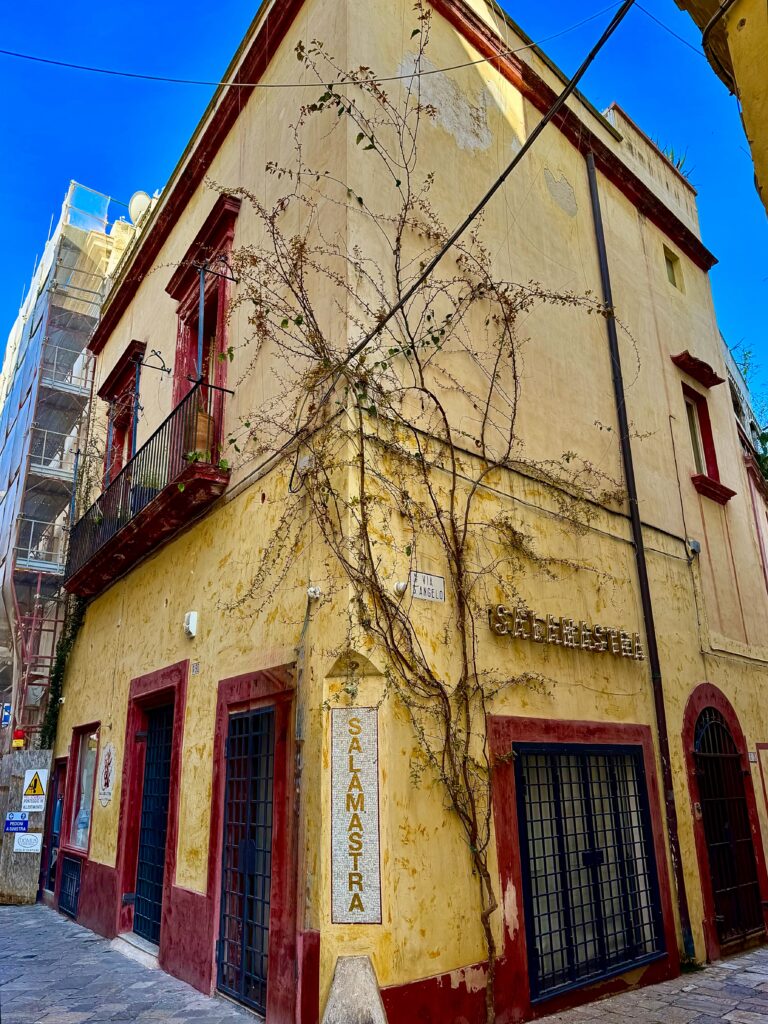
For those who like structure, a more detailed walking itinerary is suggested at the end of this guide.
Parking
Driving into Gallipoli from Lecce or the Lecce direction is straightforward. Once you come off the SS101 highway, it’s pretty much a continuous road along Via Lecce all the way into Gallipoli. Set your GPS for Parcheggio Porto Gallipoli. This will take you off Via Lecce before you hit the centre of Gallipoli, and onto Lungomare Marconi, leading you all the way into the parking adjacent to Gallipoli’s old town. The GPS instruction at the relevant time is “at the roundabout [traffic circle] take the first exit on onto Lungomare Marconi”. The only confusing thing is that where this roundabout is doesn’t in fact look or feel like a roundabout. Plus when it arrives, the split between Lungomare Marconi and Via Lecce is one immediately coming off the other. Just veer to your right as soon as the road starts to curve, and you will automatically move onto the Lungomare Marconi and into the port.
If you miss it, and end up going on Via Lecce, don’t worry. Just continue along Via Lecce and onto Corso Roma. Continue to the Fontana Monumentale di Piazza Aldo Moro roundabout (traffic circle) at the top of Corso Roma. Here you have two options in front of you. Corso Roma continues on your right and on your left is Ponte Papa Giovanni Paolo II, the bridge to the old town. This is a ZTL, a prohibited traffic zone during certain hours. Stay on Corso Roma which (i.e. the right, continuing straight ahead), leading into the port. Do not drive onto the bridge into the centro storico. If the ZTL is active, you will be fined 100 euros.
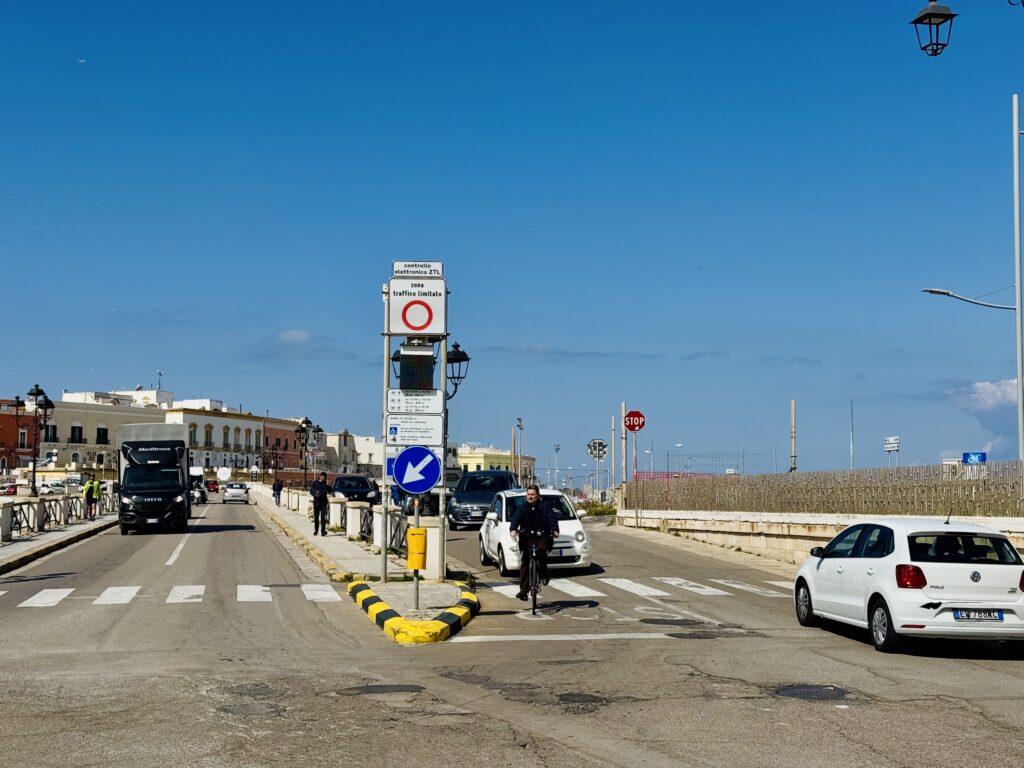
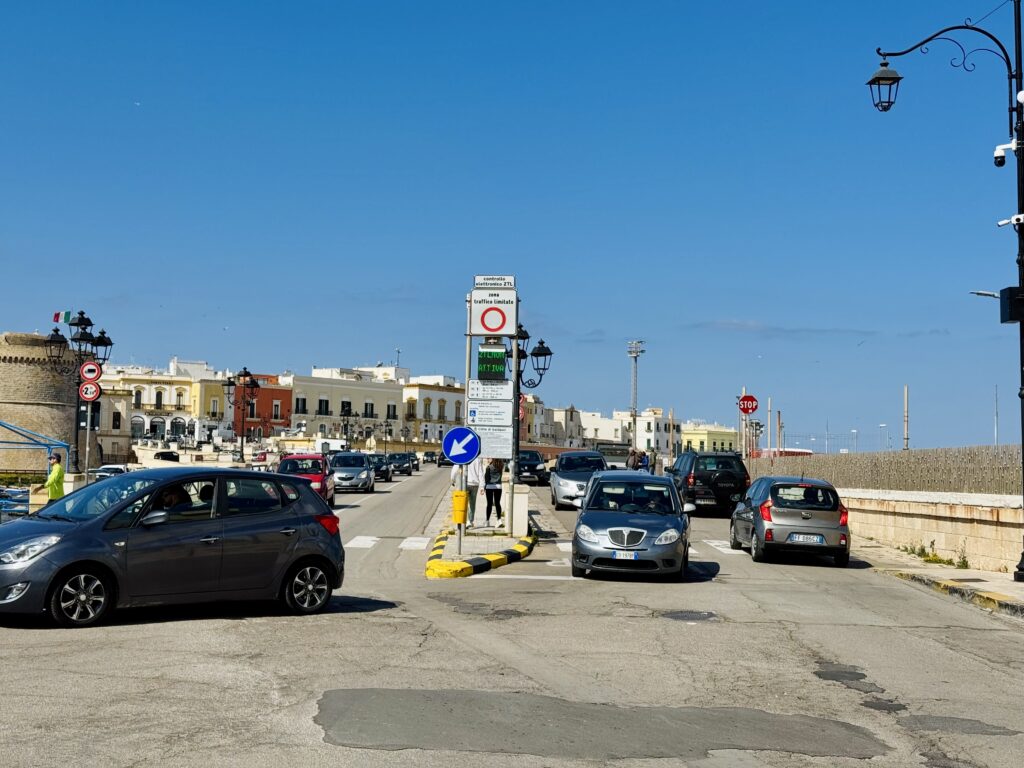
Alternatively you can park along Corso Roma as you drive up along it, pay parking in the blue lines, and from there you can walk over the bridge.
Parcheggio Porto Gallipoli has free parking in spaces in the first zone after you enter the port, marked by white lines and paid for spaces within the blue lines in the second zone. The spaces within the white lines in the 3rd zone are for residents only (indicated PASS A). Parking payment machines accept coins and credit cards (and you will need to know your licence plate number/car registration to input into the machine for your ticket (in Italian, the “targa”). From there you exit on foot via the steps up into the old town at either end of the car park.
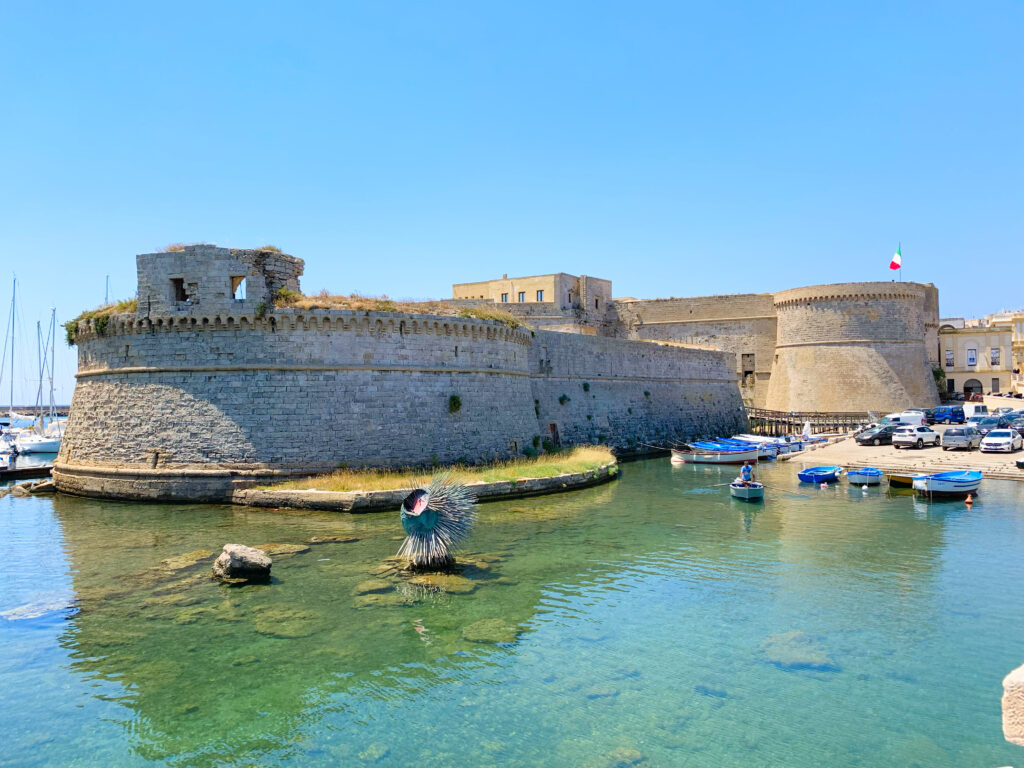
The Castle of Gallipoli | Start your journey around the old town at the Castle of Gallipoli, perched on the town’s eastern edge. Dating back to the 13th century to defend the town from invaders, this fortress is now a cultural centre. Climb its ancient ramparts for panoramic views of the surrounding sea and town.
Walk the Sea Wall | Walking around the town’s perimeter to spot charming seafront cafes, restaurants, and observe fishermen at work in their colourful boats by the port is a good way to take in Gallipoli at the start of any visit.
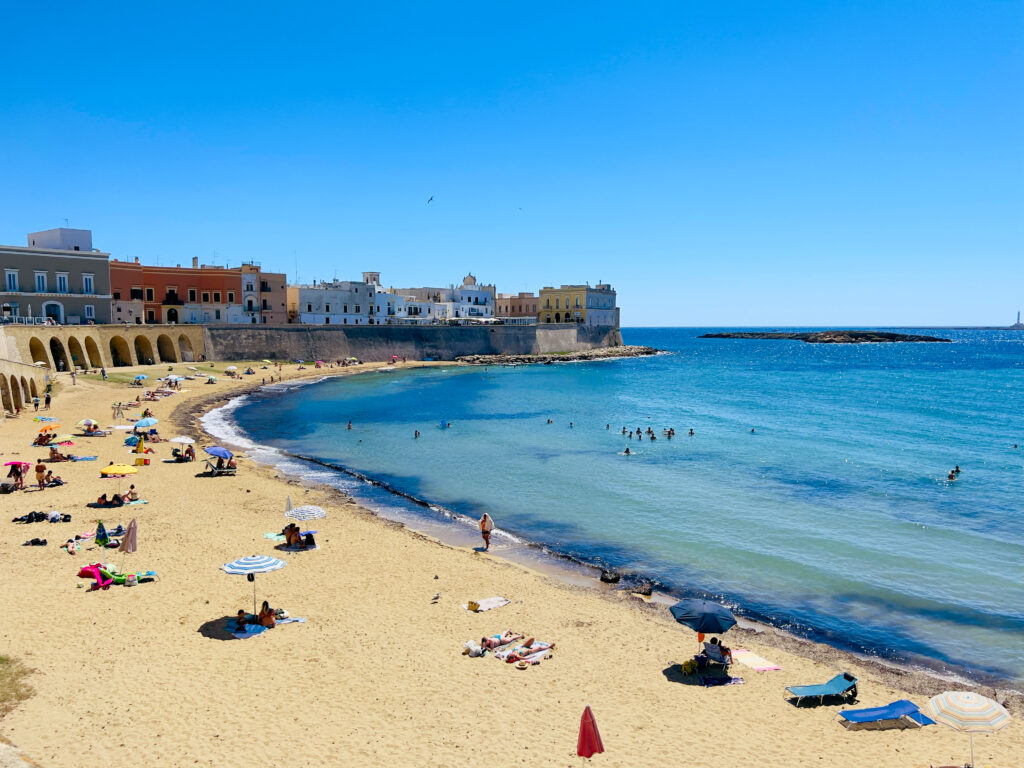
Spiaggia della Purità | The city beach marks the half-way point around the old town perimeter. A favourite city beach, la purità is the perfect place to soak up the sun and sea breeze, and to watch the sun set of an evening.
Baroque Splendors | Stroll through the old town’s labyrinthine alleys to discover its Baroque churches. Gallipoli boasts many churches. The Basilica of Sant’Agata is an architectural masterpiece, adorned with ornate facades and elaborate interiors. At the Chiesa della Purità you might pause to gaze at the mosaic inset in the paving. As you walk around the sea wall notice the many small Baroque churches squeezed into the spaces between buildings looking out toward the island of Sant’Andrea, with its lighthouse. It is easy to imagine them as fishermen’s chapels where the Madonna of the Angels and San Luigi listened to the prayers of anxious fishermen’s wives. In fact these churches were founded centuries ago by the town’s craft fraternities – coopers, rope makers and others – reflecting Gallipoli’s history as a bustling maritime hub when its port was the export point for the wine and olive oil of the whole Salento. The wealth accumulated explains the richness of its church interiors.
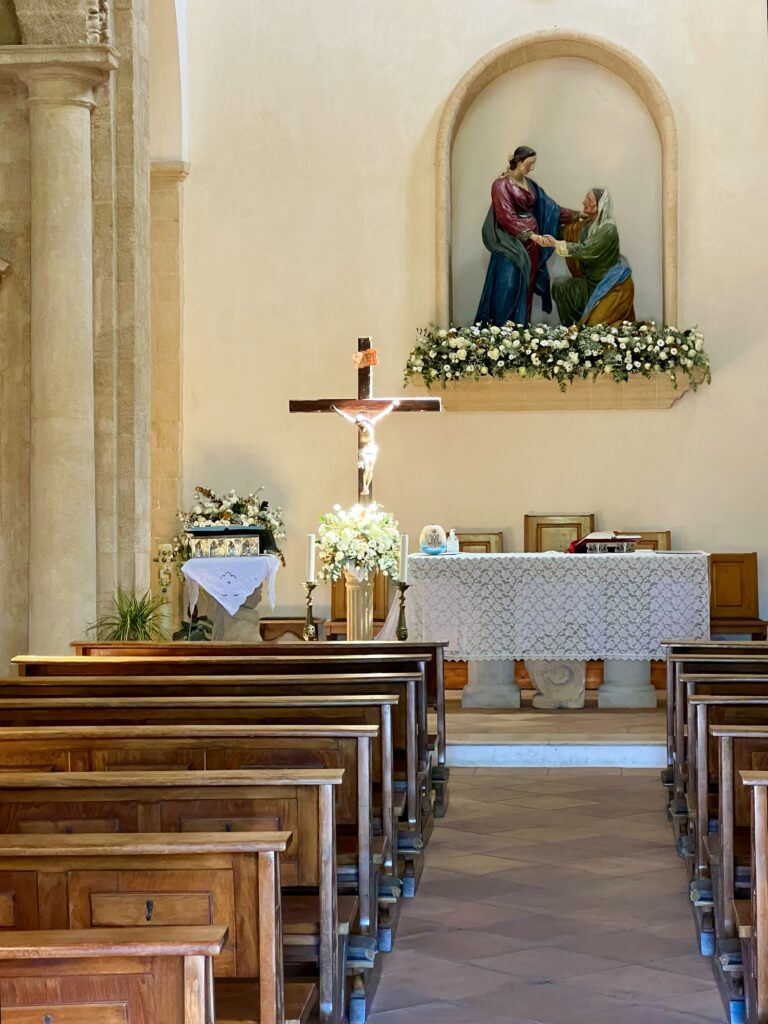
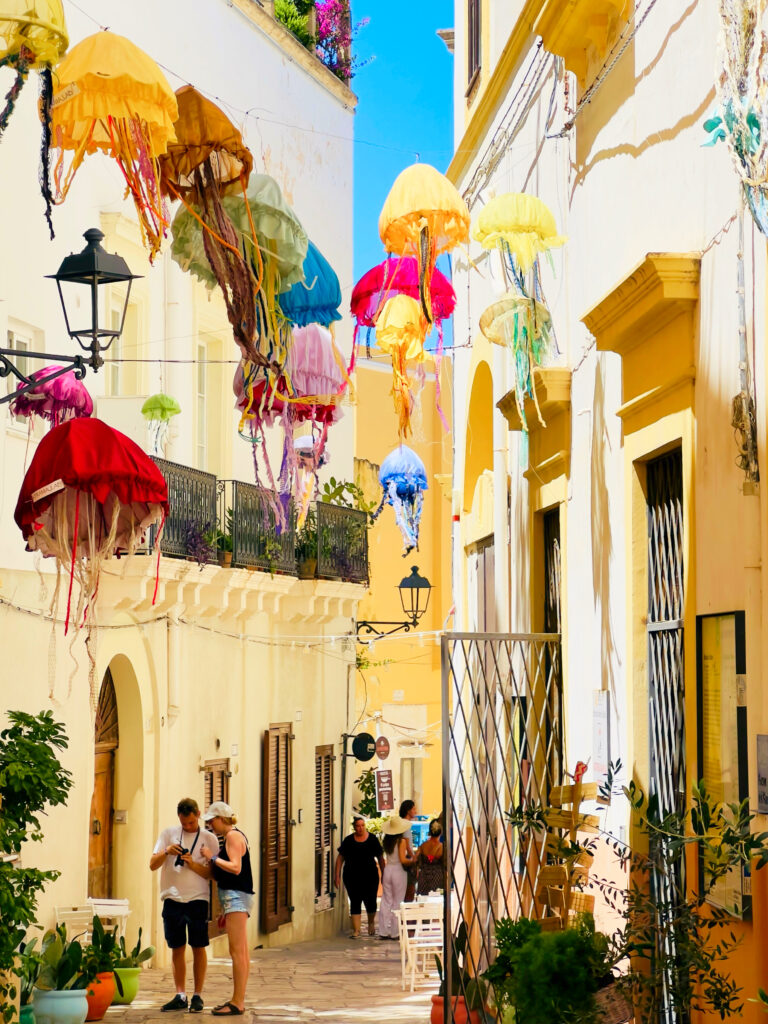
The Fishing Port | Make your way to the picturesque fishing port. Here, you can watch hard-working fishermen at work, and if you arrive early enough, you might even witness the daily fish auction. The port is also dotted with charming seafood restaurants where you can find the freshest catch of the day. There is a small retail fish market next to the bridge on the old town side most mornings. The wholesale market can be found by Piazza Aldo Moro by Santa Maria del Canneto of an evening. Beware the hazards of vespa scooters balancing boxes of fresh fishes weaving in between the people, and the swordfish snouts poking out from in between!
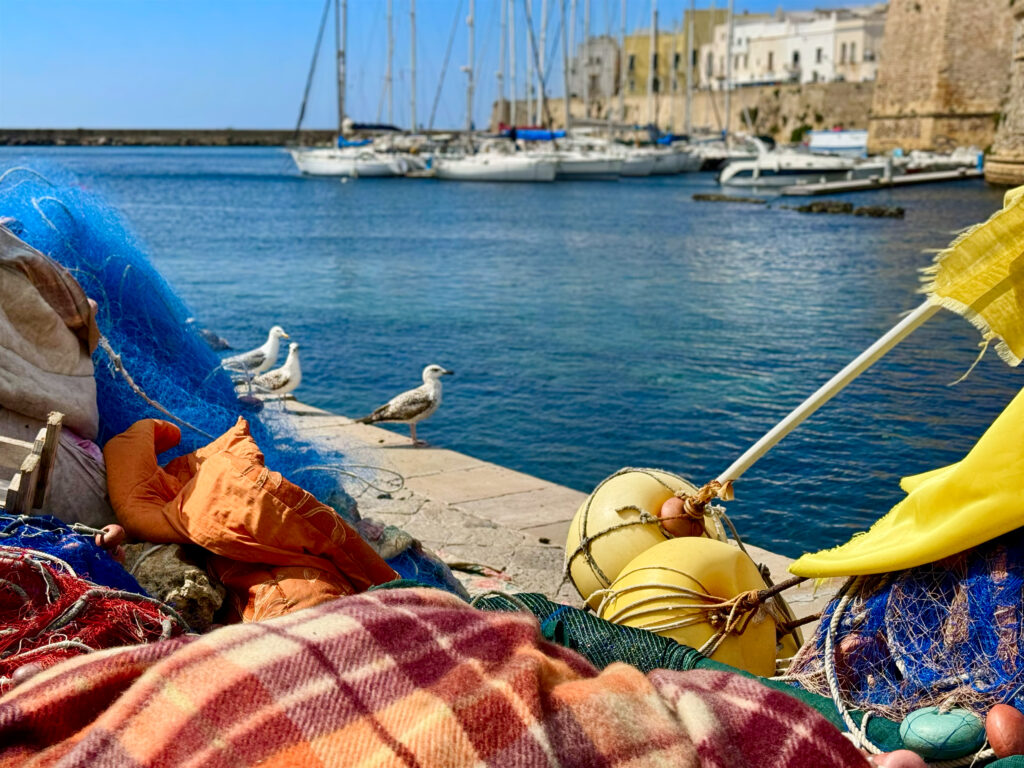
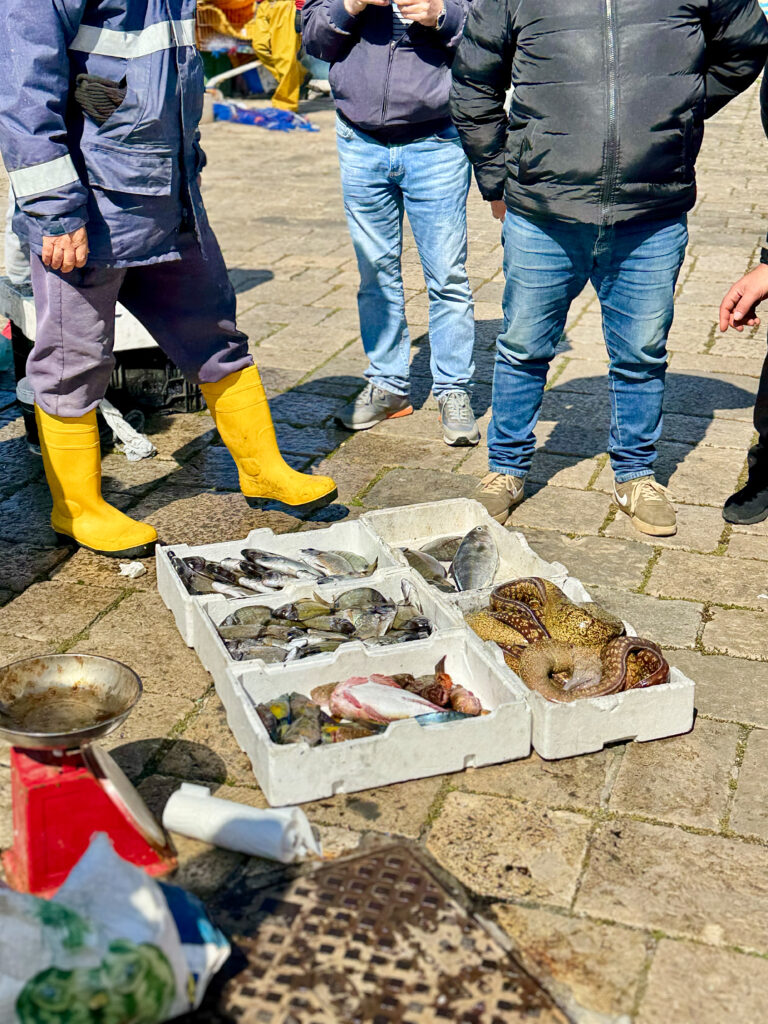
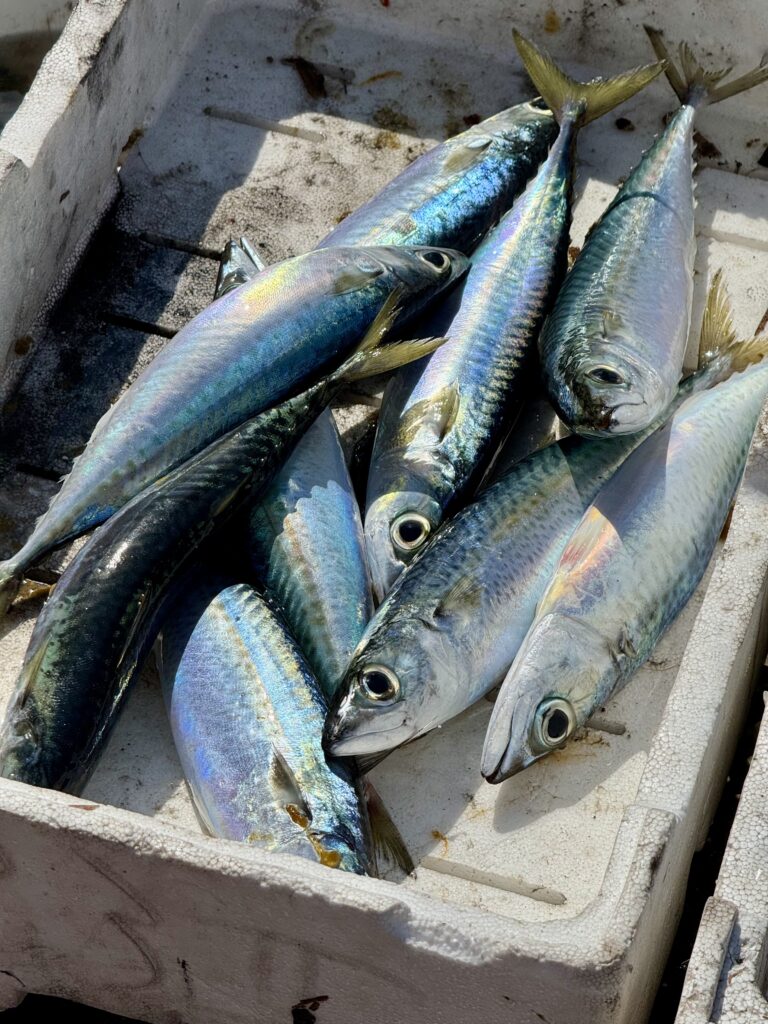
Explore the Centro Storico | Having navigated the perimeter, discover the heart of Gallipoli’s centro storico. Take your time to meander through its winding streets, alleys, and hidden corners. Here you can discover the longtime residents going about their daily business, the fishermen mending their nets or weaving lobster pots and fishing baskets.
Old Town Courtyards | Gallipoli’s old town has many “hidden” courtyards often located at the end of dead end passageways, famous for their well-preserved medieval architecture. Surrounded by narrow cobblestone streets, with whitewashed buildings adorned with plants and colourful flowers, balconies, archways, baroque columns and terraces delight the eye, you’ll feel as if you have stepped back in time. Discover quaint shops, artisan boutiques and local artisans showcasing traditional crafts.
Gallipoli Sunsets | Gallipoli offers breathtaking sunsets. Savour this daily spectacle with a glass of local wine and olives from a rooftop terrace or on a nearby beach.
Festivals | If you visit during Carnevale (leading up to the start of Lent), Holy Week (the week leading up to Easter) or the Festival of Santa Cristina (July 23-25) do not miss out on the local traditions and ceremonies. The most evocative is Holy Week, a solemn time. During Santa Cristina, respectful traditions are mixed with fun festivities. Fishermen dedicate prayers to Saint Christina before going out to sea. There is a procession followed by street food (try the traditional scapece – fried fish that has been marinated in vinegar, breadcrumbs and saffron – and cupeta, an almond brittle of toasted almonds in caramelised sugar). Santa Caterina’s statue can be found in Santa Maria della Purità.
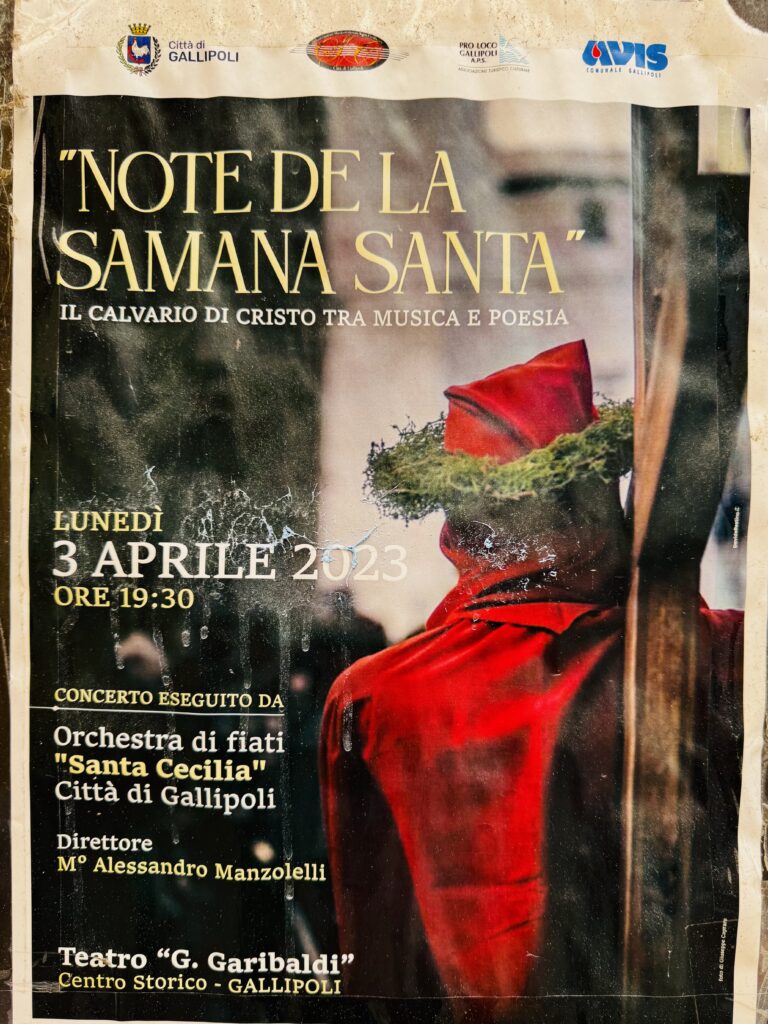
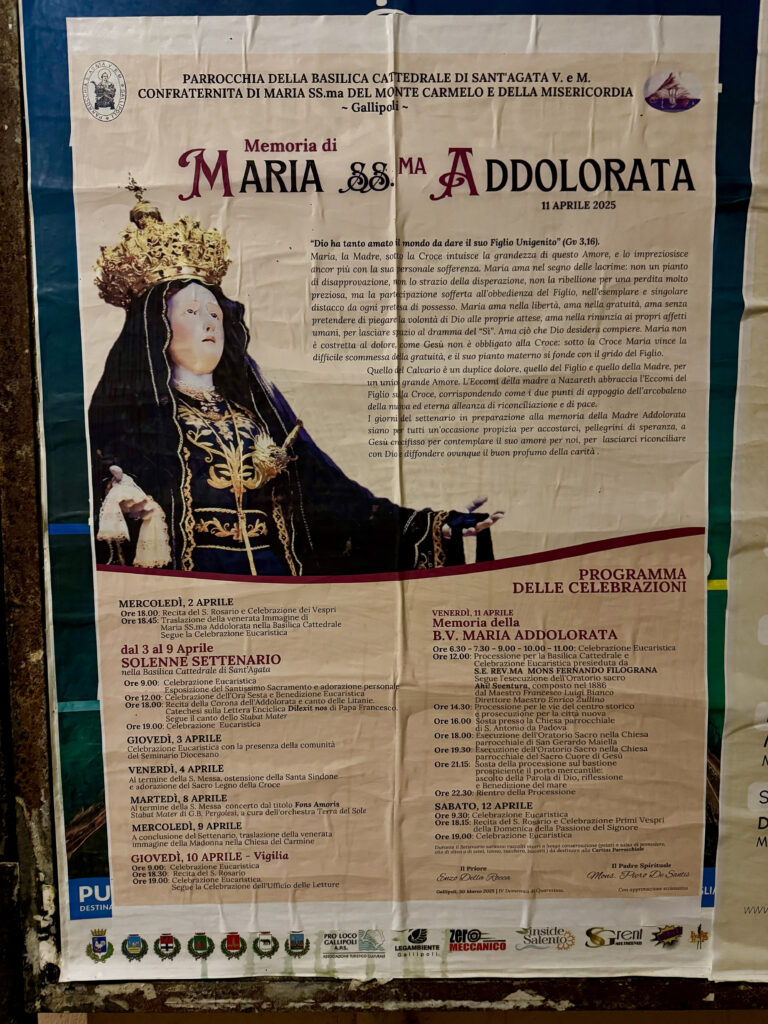
Tradition dictates that we do not swim in the sea on 23 July. This goes back to 1807 when it is said a local boy who did not respect the religious festival was “punished” by drowning at sea. Over the years “outsiders” who have arrived in town, unfamiliar with the respect that must be shown by not swimming on the feast day, have drowned. The last recorded incident was in the 1960s. It is said that Saint Cristina “porta la steddha” (she carries the star). However other fun can be had: look out for the “canneto marina” competition, the greasy pole that youthful participants will try to run up to grab the flag at its end, most instead falling into the sea!
Day Trips | Gallipoli’s location makes it an ideal base for day trips. Head south to Santa Maria di Leuca, which has a unique belle epoque feel, or cross over to Otranto on the Adriatic. It’s an easy drive to Lecce, or head up the Ionian coast to Nardò and the wonderfully wild Porto Selvaggio beach and nature reserve.
Gallipoli | Where to stay
We recommend staying in the old town. We always stay in one of the stunning Palazzo Presta boutique hotels. Privately owned, in the heart of Gallipoli’s old town, there are three locations. Palazzo Presta and Palazzo Flora, each with 10 rooms, and the smaller Palazzo Colombo which is on the seafront with rooms overlooking the old port.
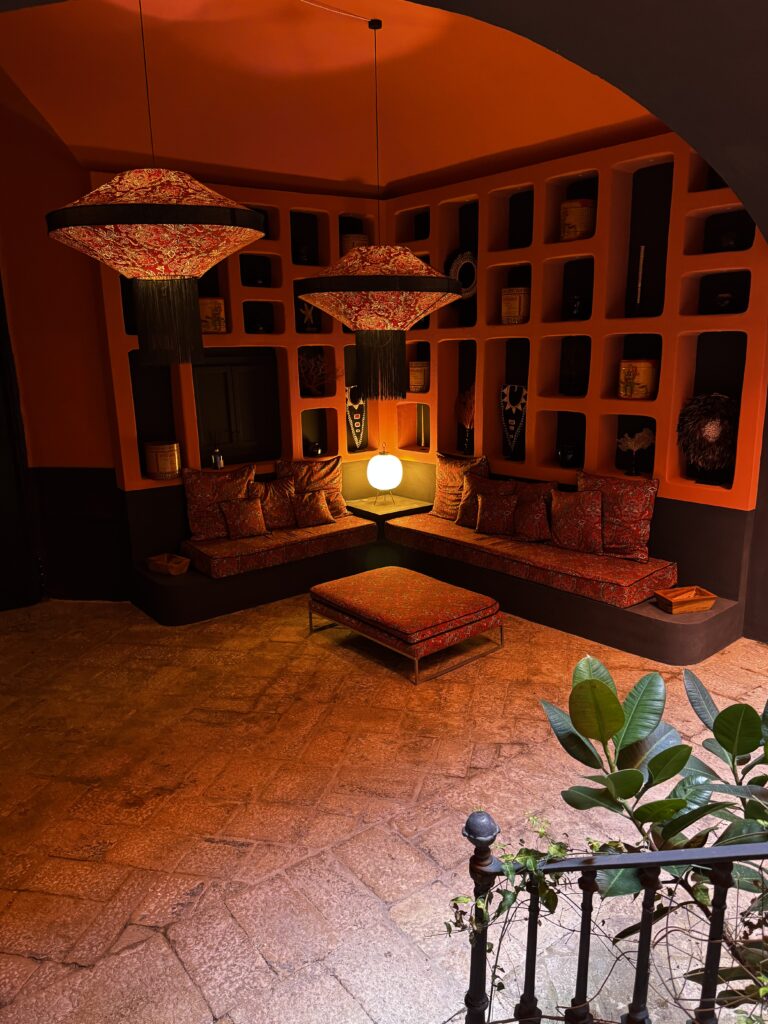
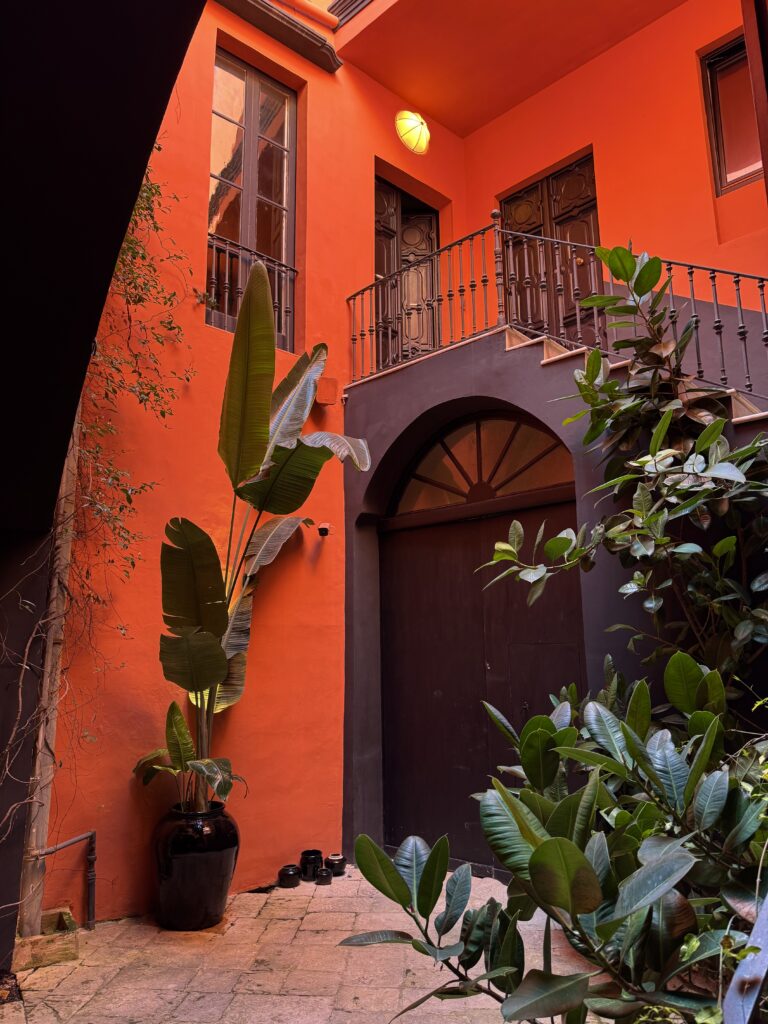
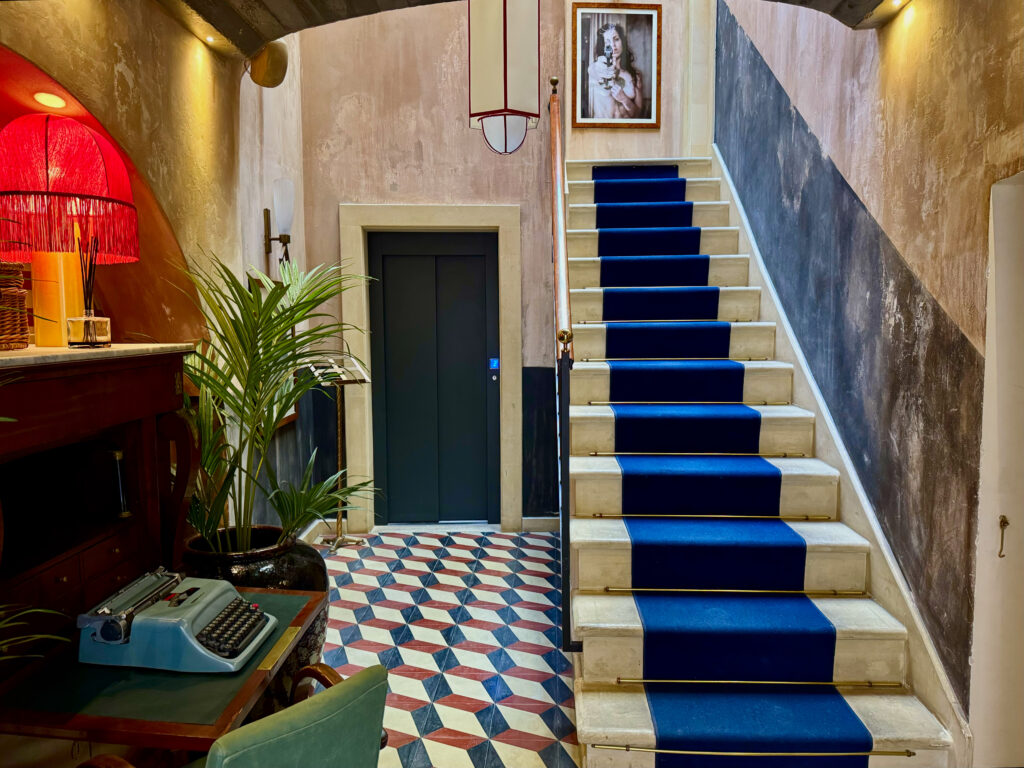
Each has a different feel, and it is hard to choose a favourite. Each is beautifully decorated. Flora had the biggest ”wow” impact with the courtyard entrance, the chic reception and from there the contrast of the communal guest room, leading out onto the terrace, with its own swimming pool.
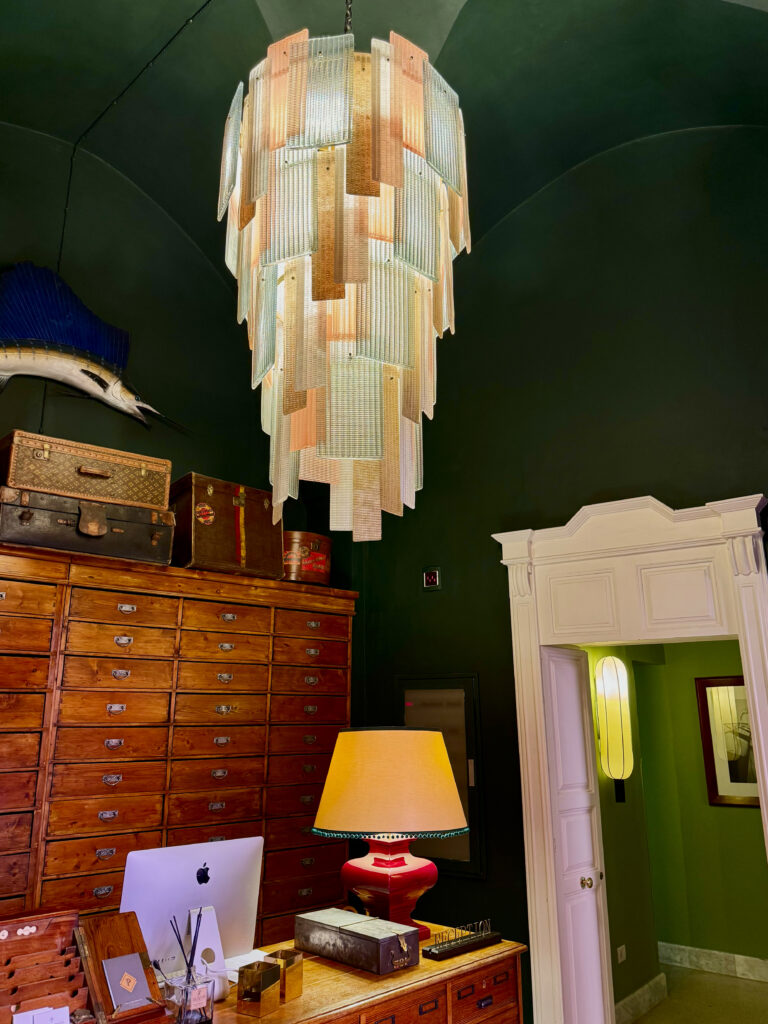
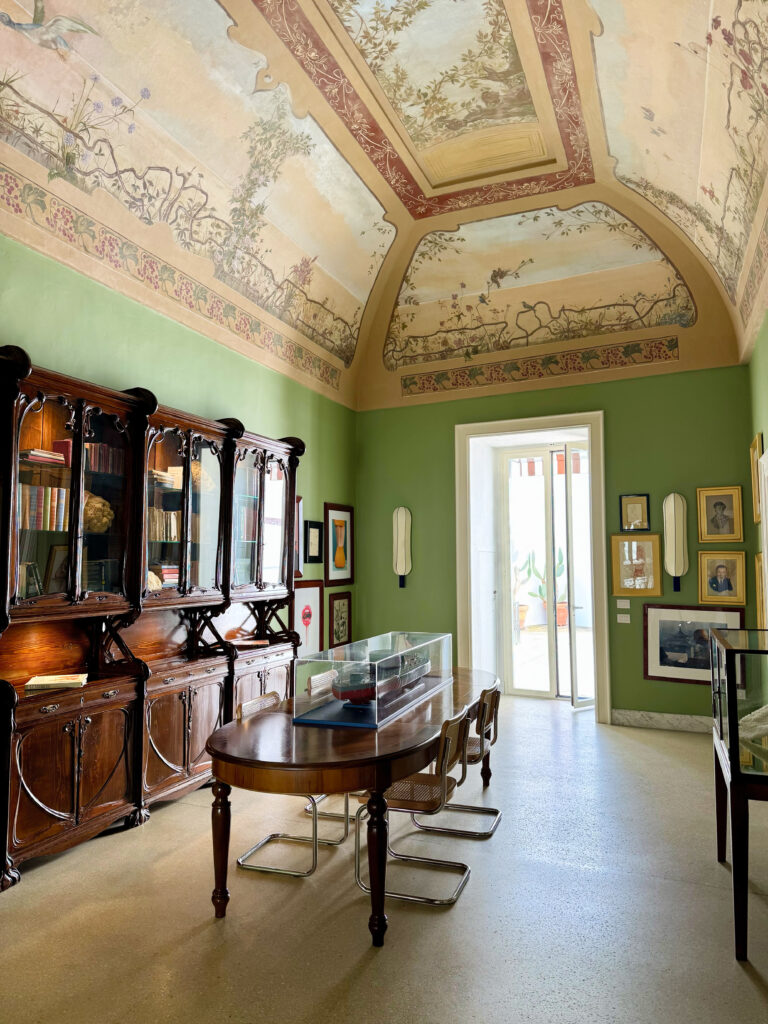
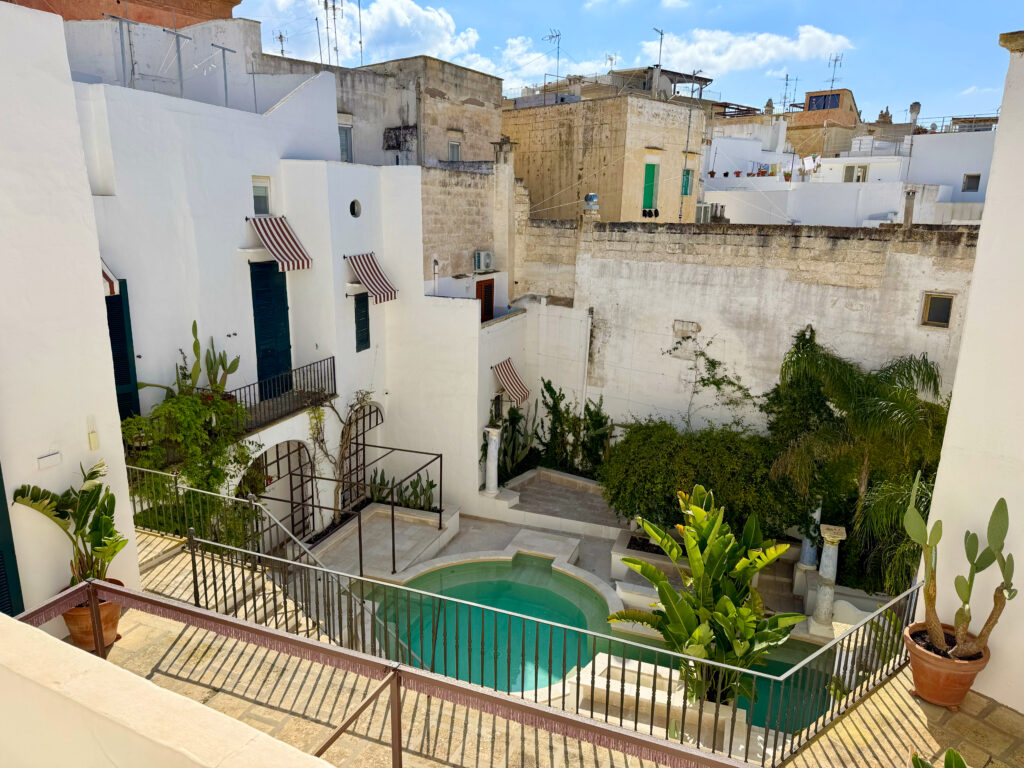
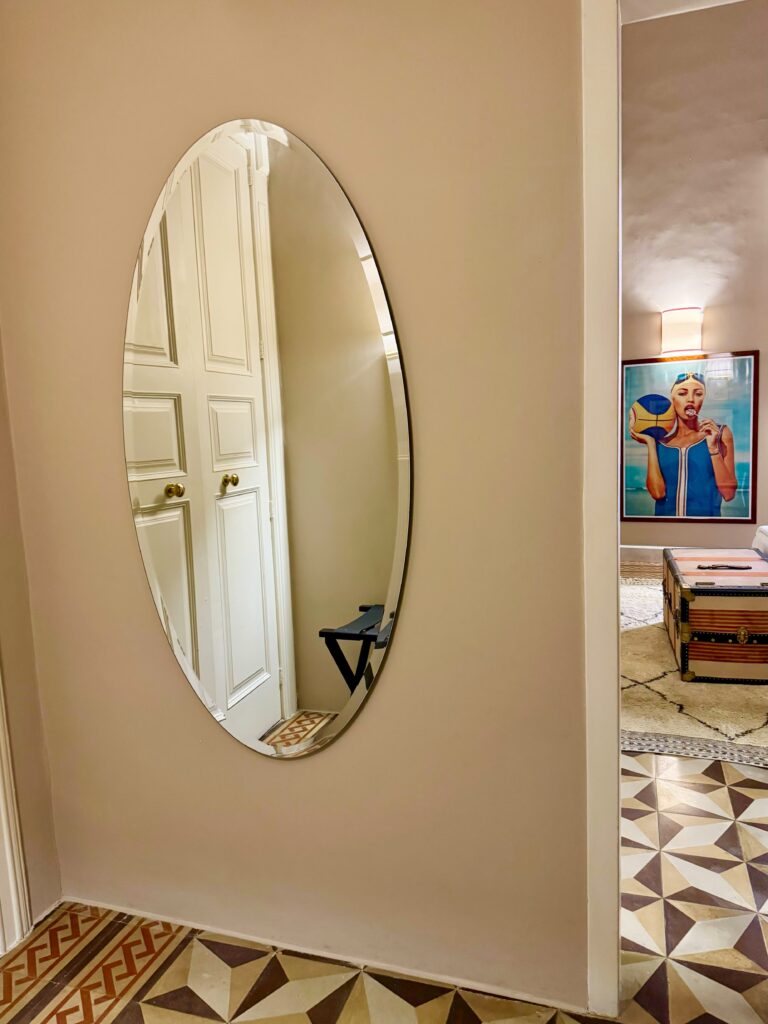
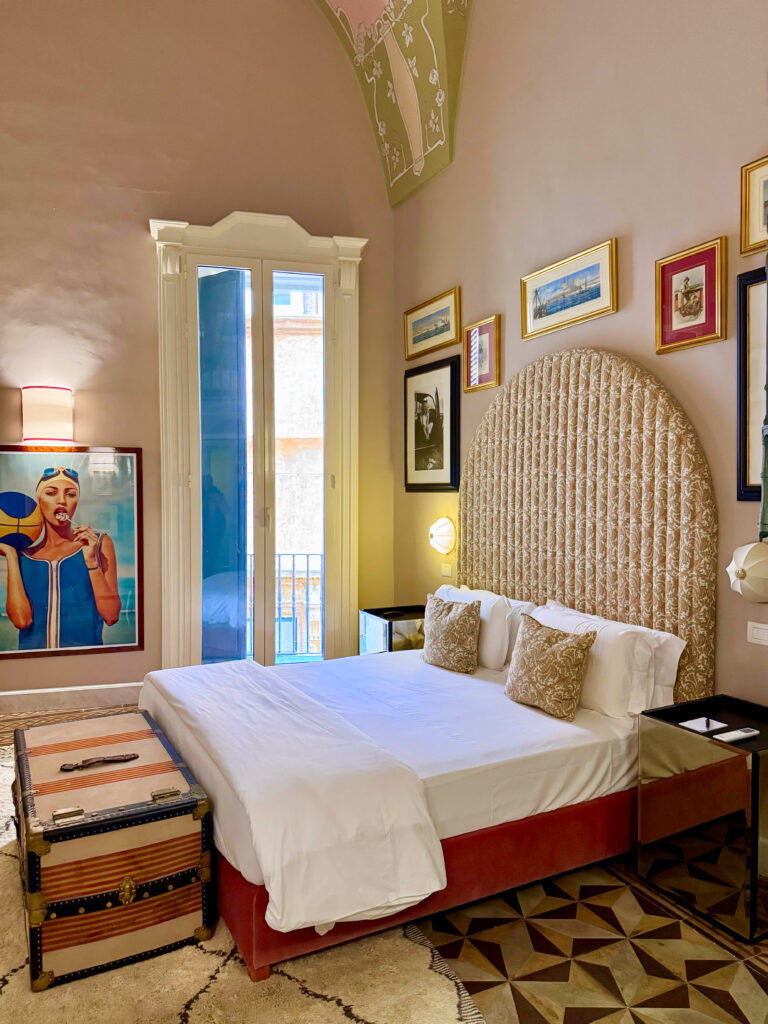
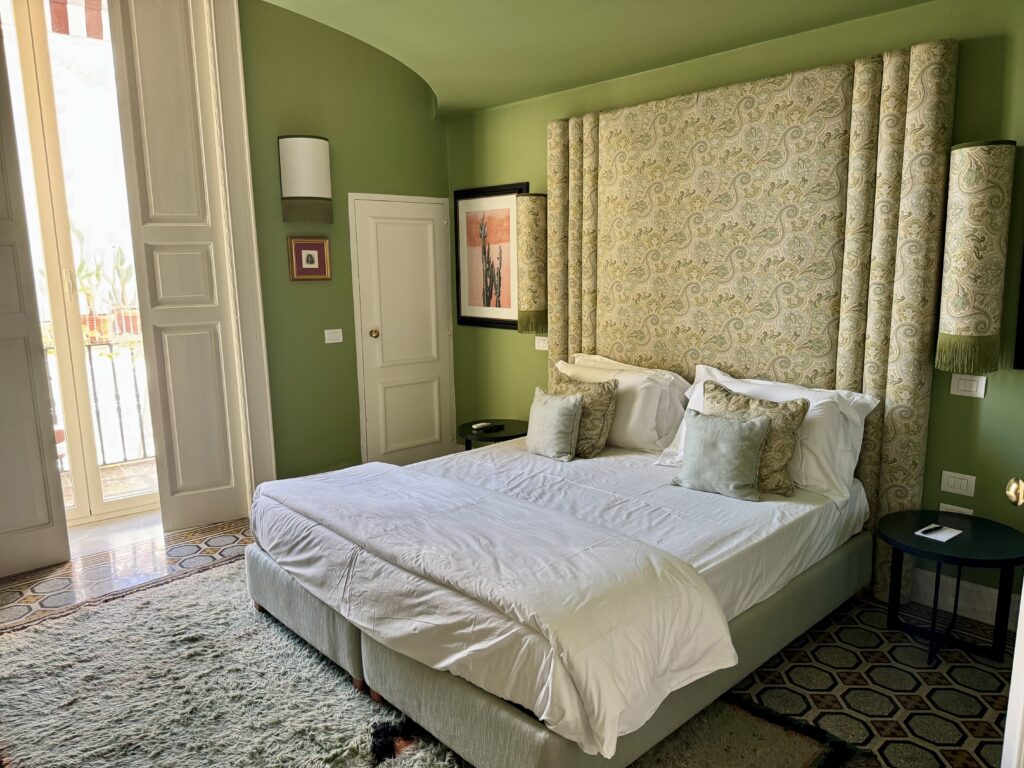
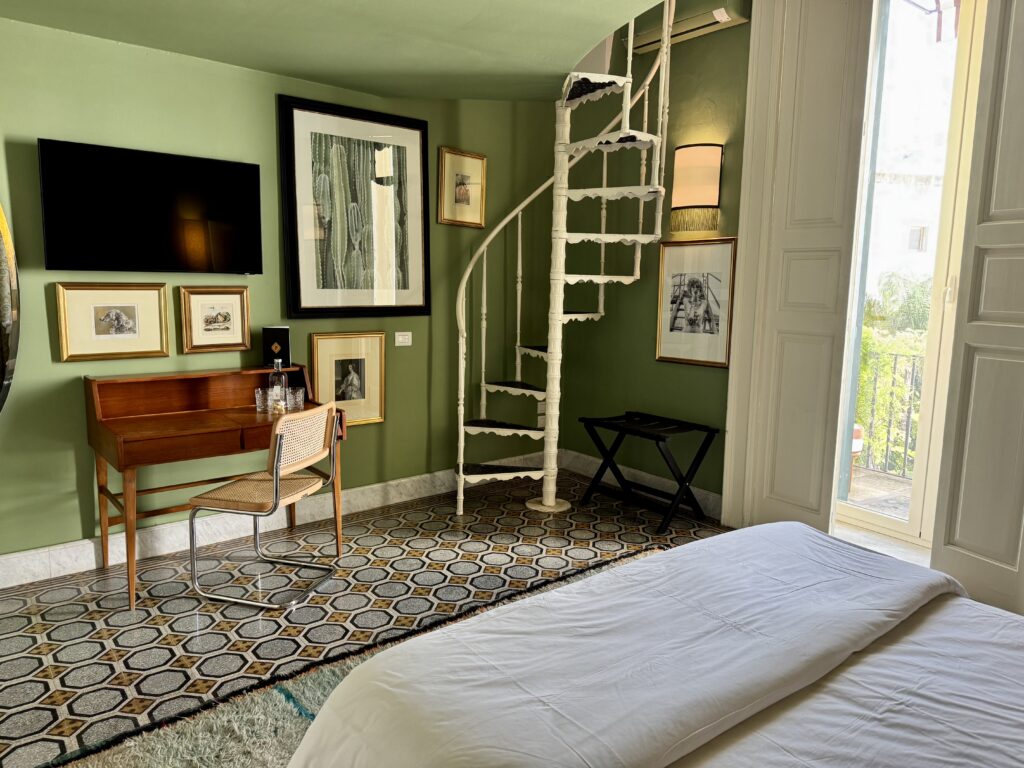
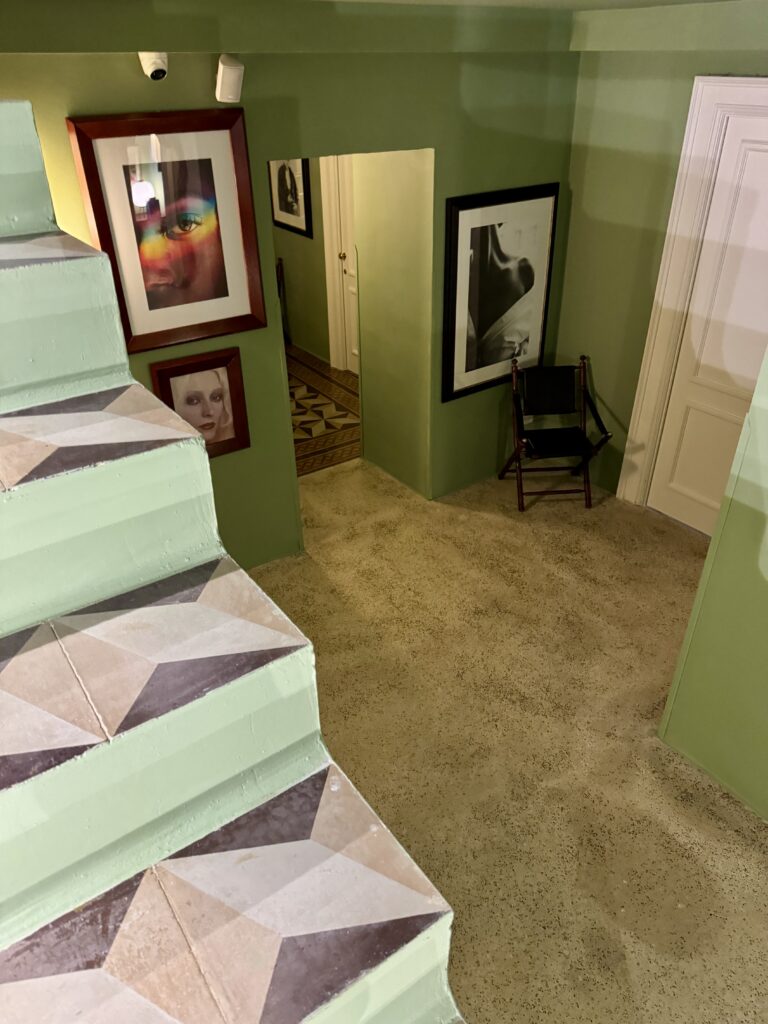
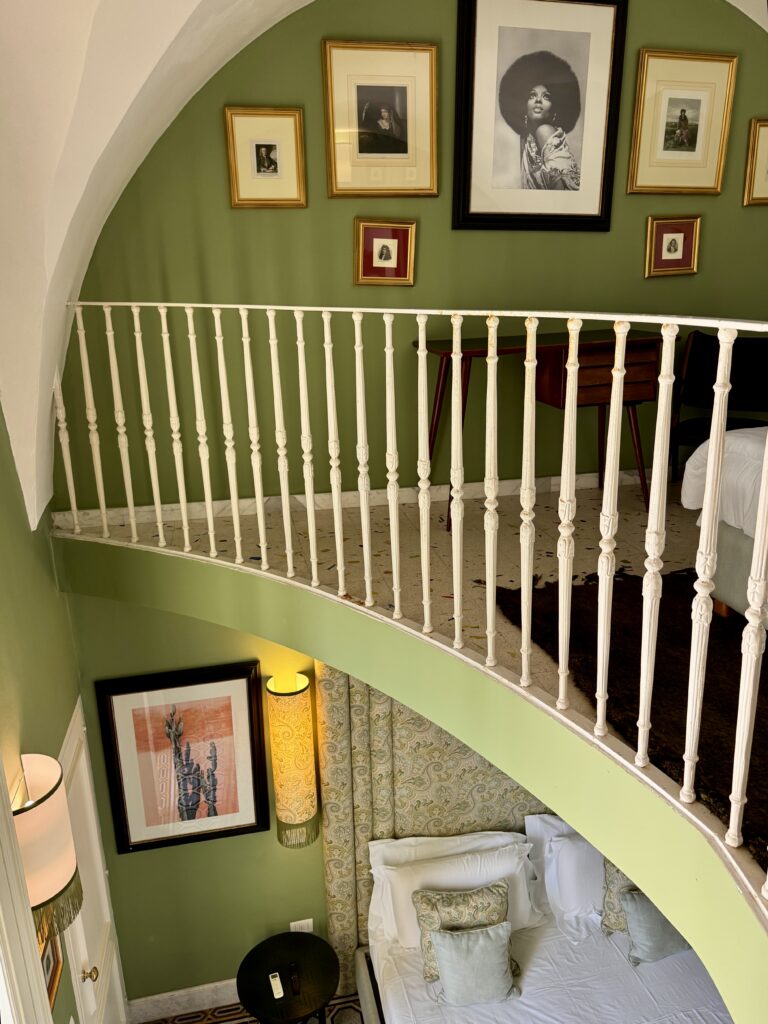
The sea views from Palazzo Colombo were perfect when we visited in April. But anytime between mid-June to mid-September we would not recommend Colombo. It is on Riviera Cristoforo Colombo, which is especially busy with traffic, tourists and noise all night through to early morning during the busy vacation period. But the hotel will tell you this themselves. The comfort of their guests is important. But any other time (we visited in April) it is perfect, especially if you want a balcony opening onto the seafront.
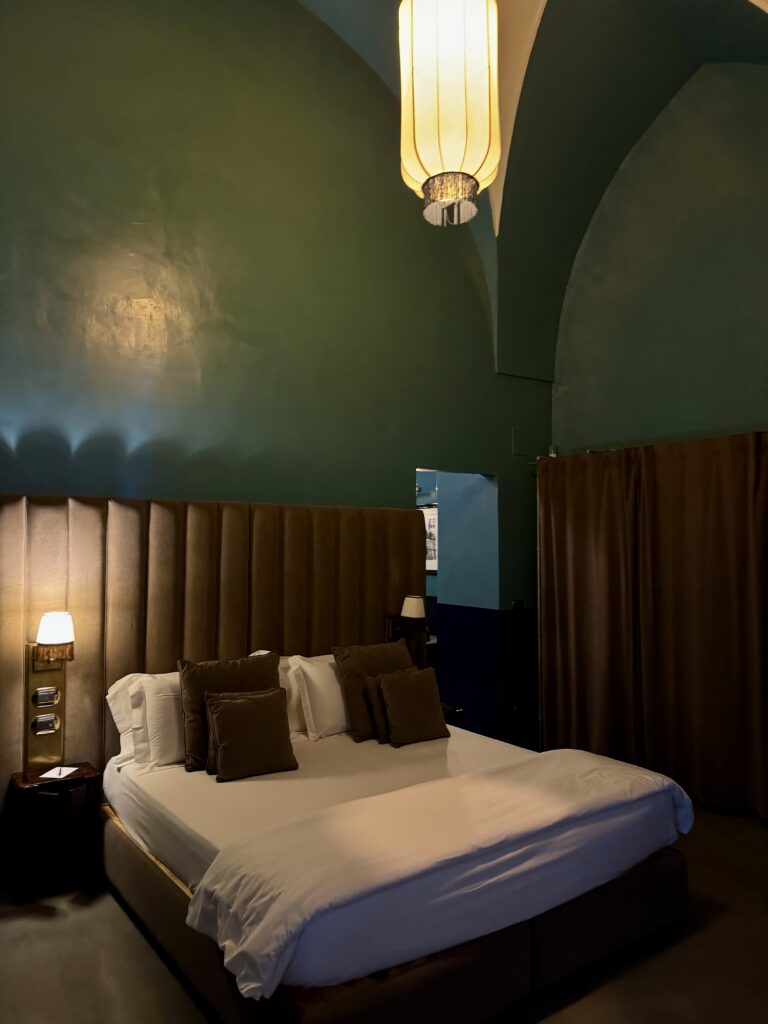
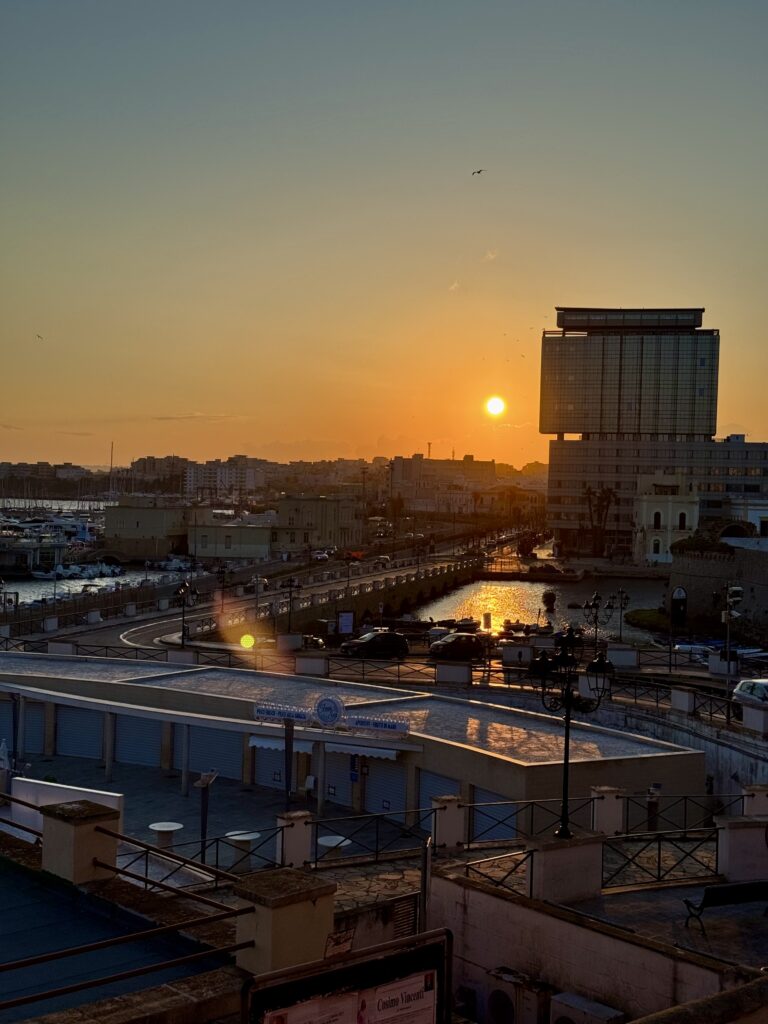
Ay any other time of the year, stay at Palazzo Presta or Palazzo Flora. Staff are incredibly friendly, courteous and enthusiastic. The breakfast (included with our rate) was a pretty good way to start the day!
For a private apartment choose somewhere in the old town. Booking.com usually have the best selection. When we stay at Baia Verde for the beach clubs and lido we choose the least expensive apartment, given these are modern, without character and we aren’t choosing them for comfort!
Taste Gallipoli | Where to Sip and Savour:
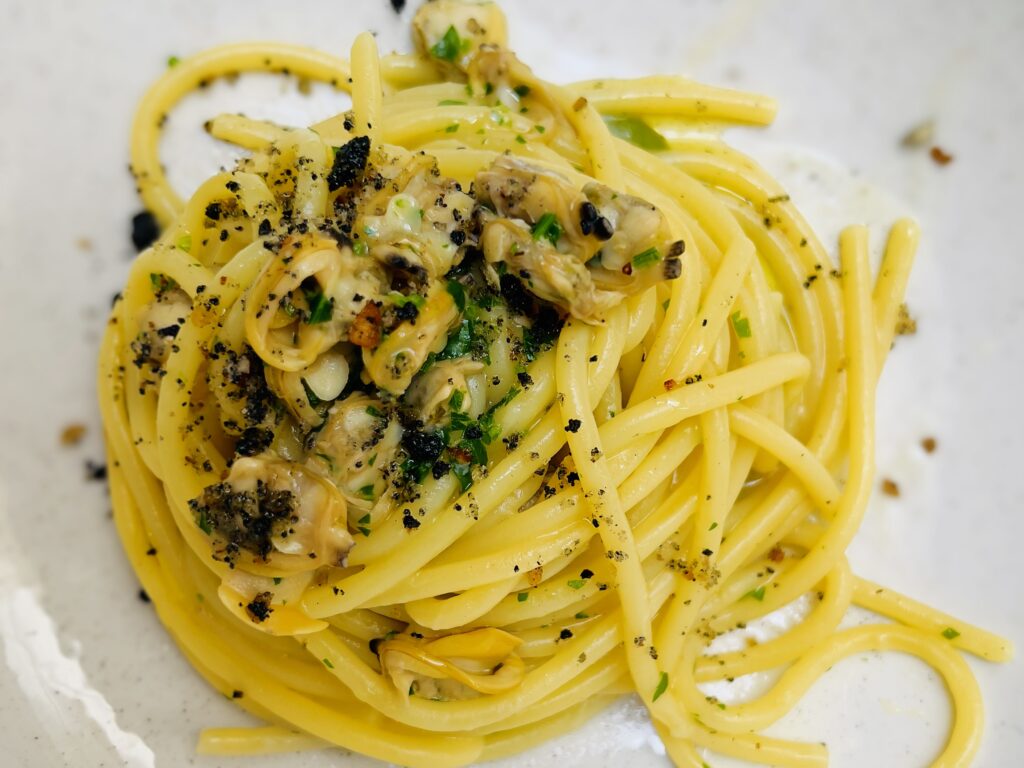
As usual, good for is only just around the corner wherever you are in Puglia. Bad food is hard to find. We encourage you to follow your nose rather than fret over fear of missing out. But by way of appetiser we keep going back to:
- Trattoria La Puritate: For lunch or dinner, head to La Puritate, a rustic trattoria known for fresh, top quality seafood dishes, all while enjoying the serene views of the sea. The restaurant is next to the Chiesa della Purità, sitting above spiaggia della Purità. Popular with locals, we suggest linguettine alla Puritate as primo (small linguine with small prawns, thin strips of courgette and cherry tomatoes) followed by the theatrical gamberoni al sale (sweet and succulent Gallipoli red prawns). | Via Sant’Elia, 18 | trattorialapuritate.it
- Ristorante Il Bastione: Family run restaurant whose fresh seafood comes from the fishmarket stall of their fisherman brother. Beautiful panoramic views over the sea, and a perfect view of sunset | Riviera Nazario Sauro, 28 | ilbastionegallipoli.it
- Osteria Briganti: Hidden away in the alleys of the old town you will enjoy delicious and reasonably priced trattoria style home cooking. A local favourite known for its seafood (you can’t escape it in Gallipoli) | Via Antonietta de Pace, 107 | Osteria Briganti Gallipoli Facebook
- Ristorante La Vinaigrette: A simple, modern restaurant on the old town seafront specialising in typical Salento dishes using seasonal produce revolving around the catch of the day | Riviera Armando Diaz, 75 | lavinaigrette.it
- La Corte | Palazzo Grumesi: Pizzeria serving up tasty Neapolitan style pizza, but not only! Known for some unique takes on seafood pizzerias. Nice courtyard setting and friendly service | Riviera Nazario Sauro, 47 | La Corte Pizzeria Facebook
- L’Angolo Blu: Seafood restaurant where we were tempted to try the risotto di crema di scampi, which was cooked perfectly to the bite (also important for rice, not just pasta) | Via C. Muzio, 45
- Da Clara: Another favourite recommendation often made by locals. Catch of the day and simple seafood pasta dishes | Via Antonietta de Pace, 15
- Blanc Cafe: Lounge bar in a chilled setting with nice outside terrace, perfect for cocktails and aperitivi | Via XXIV Maggio, 19
- Martinucci: No visit is complete without gelato. Satisfy your sweet tooth at Martinucci where you can indulge in a variety of artisanal gelato flavors | Riviera Armando Diaz, 129
A reminder that all restaurants in Italy charge a “coperto” per person cover/service charge. This is not unique to tourists. All diners, including locals, pay the coperto. Technically it covers use of the tableware, plates, cutlery (silverware) and bread. It cannot be avoided by refusing bread when brought to you, and you will pay this even if you explain that you do not want bread. We do not tip in Italy. For more information about the coperto, check out our Puglia Guys “What is the coperto on my restaurant check?” guide.
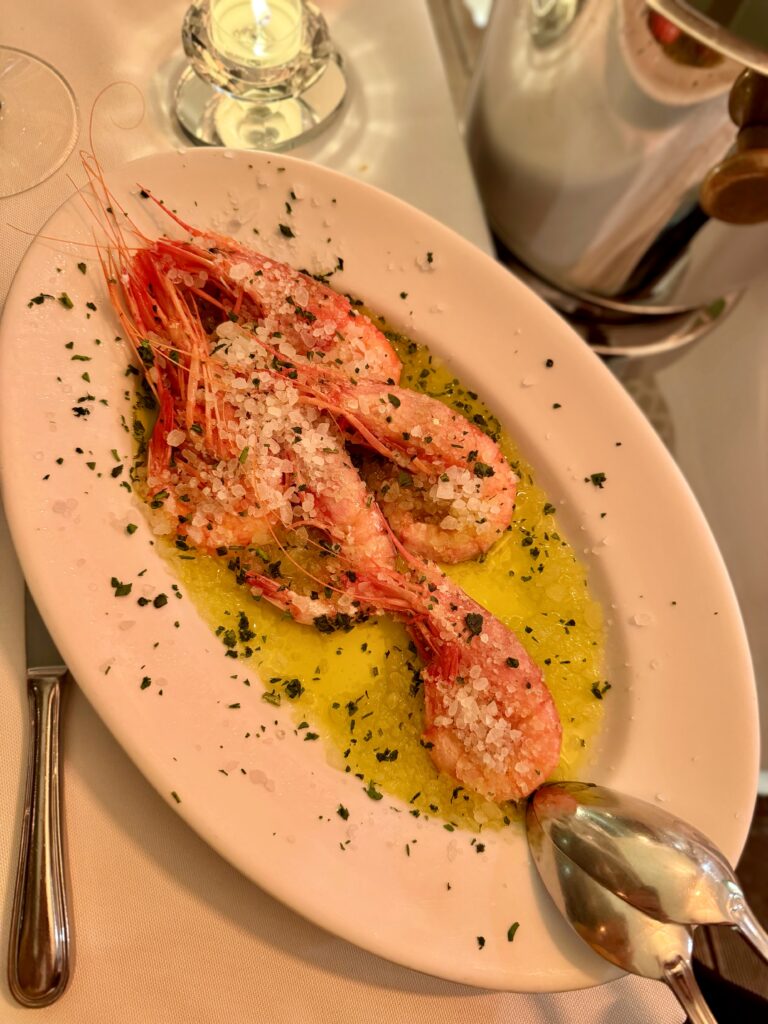
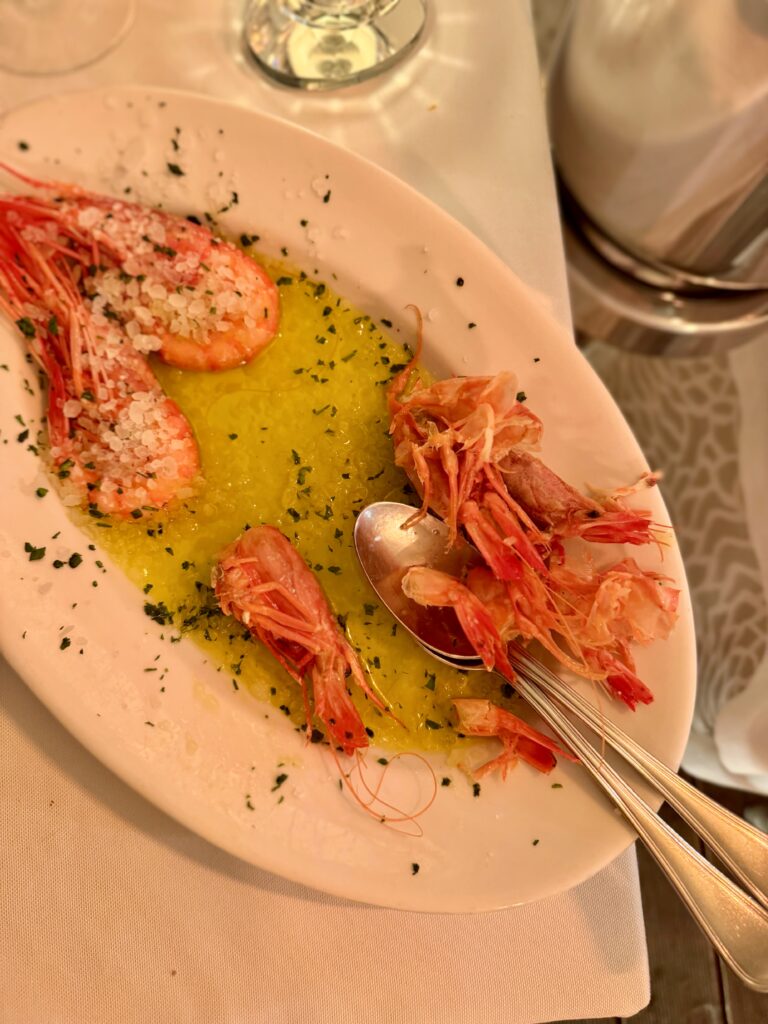
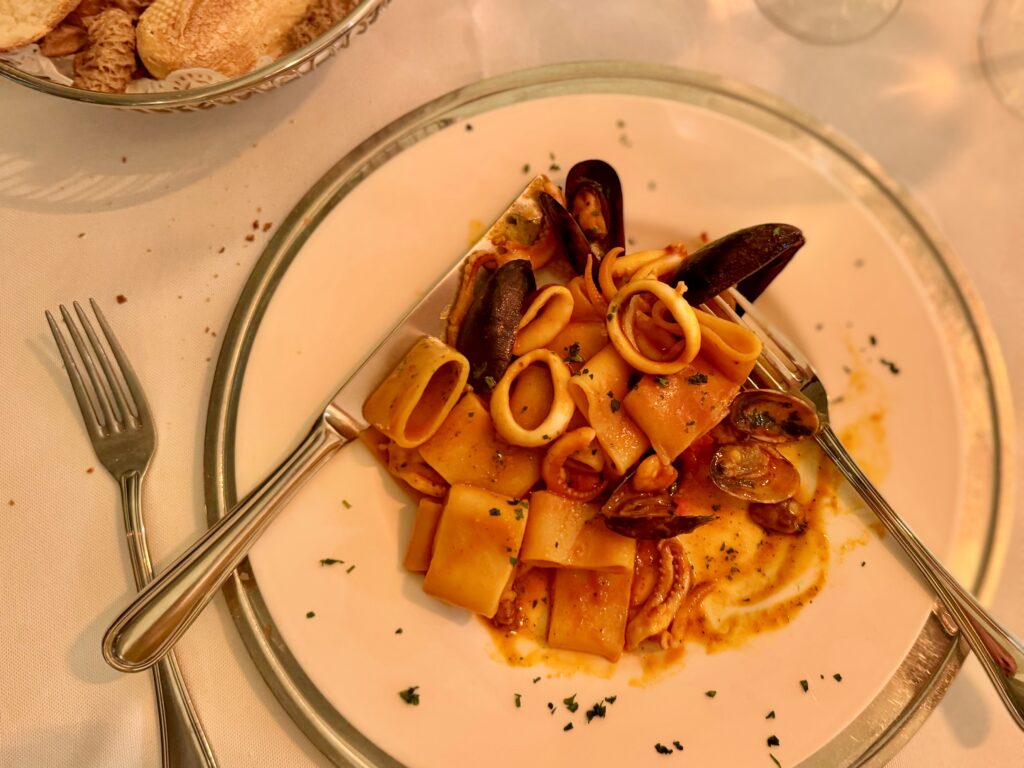
Gambero Viola di Gallipoli — the Gallipoli Purple Prawn
Gallipoli just happens to be home to one of Italy’s most prized seafood delicacies — the Gallipoli purple prawn (shrimp to Americans).
Fished from the deeper parts of the Ionian Sea, particularly in the warm months from April to September, the prawns command a premium price, sometimes exceeding €60 per kilo during the peak of summer.
Wander down to the fish market square near Gallipoli’s bustling port and you’ll see locals and chefs alike sourcing the freshest catch — a daily ritual that comes alive especially around sunset, when fishing boats return with their haul.
Their meat is succulent, sweet, and delicately briny — the kind of flavour that tastes like the sea itself. They’re incredibly versatile too: grilled, gently seared, or simply served raw with a drizzle of local olive oil and a touch of lemon. From crudo platters to warm, buttery seared dishes. For something a little more unconventional Pizzeria Red Sunset (outside the old town) serves up a pizza topped with purple prawns and creamy burrata, while Pizzeria La Corte offers a bold creation called Viaggio da Gallipoli a Pachino, where the prawns are served up on pizza with cherry tomatoes and a dusting of blood orange powder, in a fusion of land and sea.
Our photos below show the difference between the raw Gallipoli purple prawns and raw regular prawns.
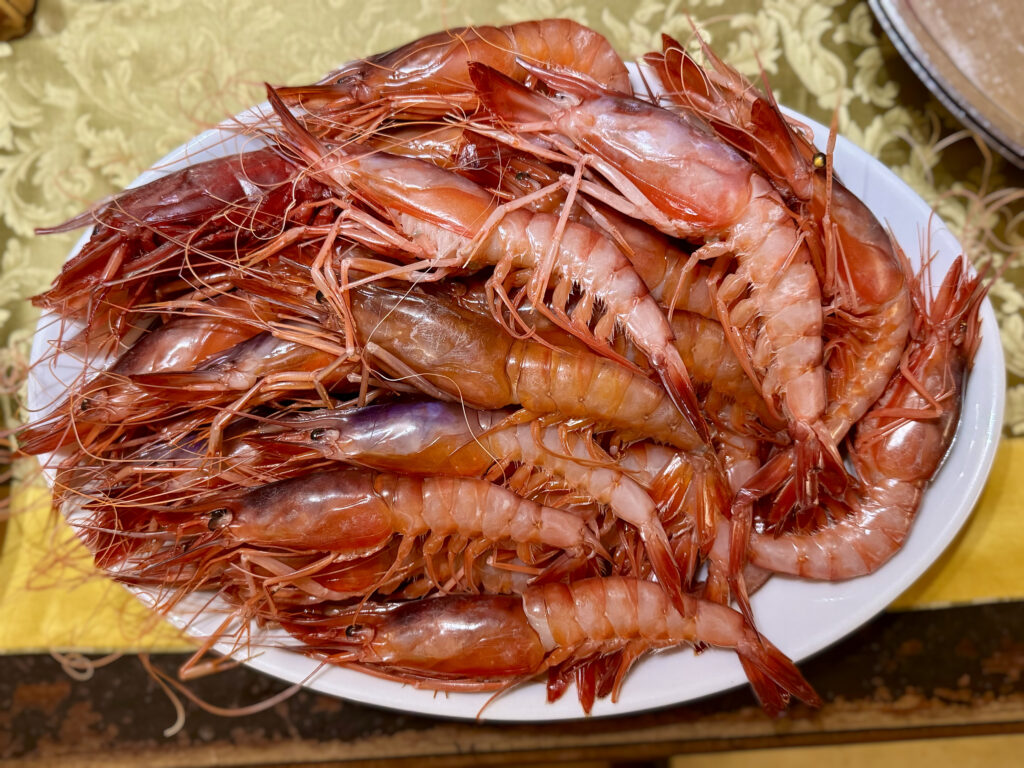
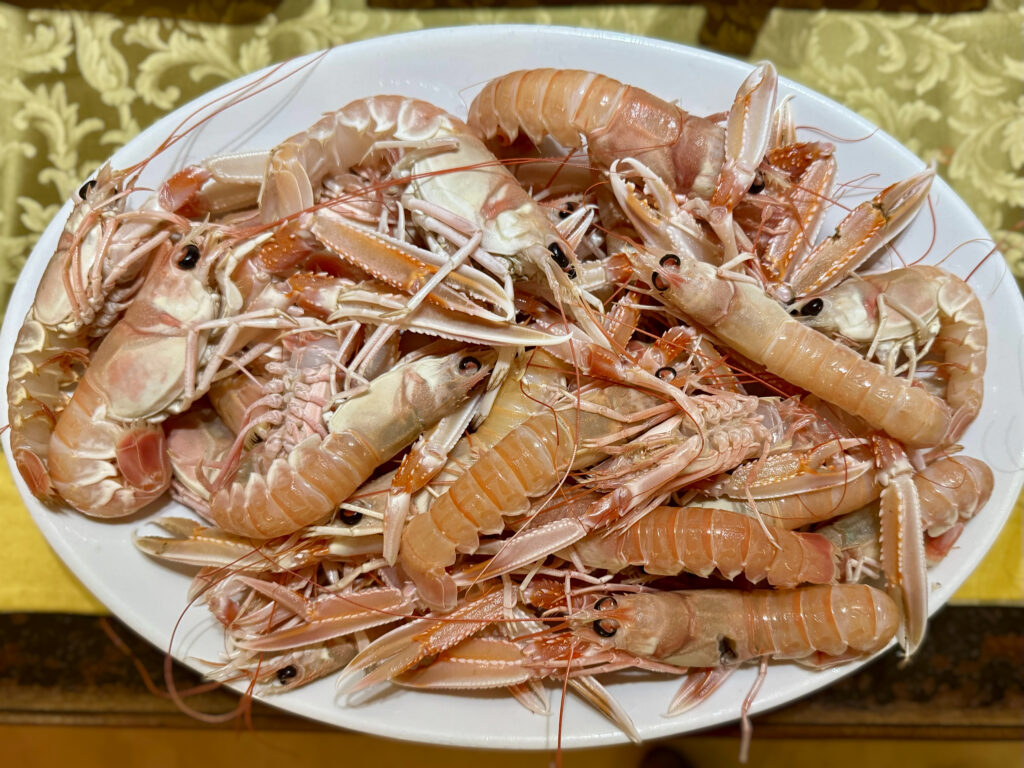
Gallipoli: In History and Culture
Historically, Gallipoli’s strategic position along major maritime routes and its natural limestone islet setting made it an ideal settlement location. While its origins remain debated, it is widely believed that the town was originally a Messapian settlement called Anxa, later influenced by Greek colonisation. The name “Gallipoli” itself derives from the Greek kalé pólis, meaning “beautiful city.” Under Greek rule, the city flourished, establishing its own institutions, minting currency, and exerting control over a vast territory stretching from Porto Cesareo to Leuca.
Gallipoli came under Roman control in 265 BC and played a key role as a military statio and later a municipium. Its importance increased with the construction of the Via Traiana in the early 2nd century AD, connecting the city to Brindisi and the wider Roman road network.
Byzantine and Islamic Influences
During Byzantine rule, Gallipoli’s fortifications were reinforced, and it became a bishopric in 551 AD. The Orthodox rite, established during this period, remained in practice until the 16th century. The town also became a centre for monastic life, with numerous hermitages and religious settlements developing in the surrounding region.
Gallipoli was a target for various invaders over the centuries, including Saracens, who occupied the town in the early 10th century. The urban layout reflects the layered influences of Byzantine and Islamic cultures, evident in its winding alleys, enclosed courtyards, and irregular street patterns.
Norman, Angevin, and Aragonese Rule
The Normans, led by Robert Guiscard, captured Gallipoli in 1071, marking the beginning of a period of expansion and fortification. Under Angevin rule in the late 13th century, the city suffered destruction and heavy taxation, but the Angevins also reinforced the castle and introduced new defensive structures.
By the 15th century, Gallipoli had become an important stronghold under Aragonese rule. The Venetians briefly occupied the city in 1484, recognising its strategic and commercial value. Following their withdrawal, the Aragonese strengthened Gallipoli’s defences, constructing coastal watchtowers and fortifying the castle.
A Flourishing Trade Hub and Baroque Transformation
From the late 16th century, Gallipoli experienced a period of relative peace, allowing for urban development within its fortified walls. By the 17th and 18th centuries, it had become one of Europe’s most important centres for olive oil trade. The city’s economic prosperity led to a boom in architectural projects, including the construction of elegant Baroque churches, noble palaces, and the restructuring of public squares. Notable religious landmarks from this period include the cathedral of St Agatha, the churches of La Purità, St Francis of Paola, and St Teresa, all adorned with intricate decorative elements.
Modern Expansion and Transformation
In the late 18th and 19th centuries, Gallipoli began expanding beyond its historic centre. The development of the Borgo Nuovo followed an organised urban plan, featuring a grid layout with uniform streets and building regulations. The construction of a new port and railway connections further facilitated Gallipoli’s growth as a commercial hub. However, modern expansion has also brought challenges, with rapid tourism-driven development impacting the city’s historic and natural landscape.
Despite these changes, the old town remains remarkably intact, preserving its historic charm and unique character. Its labyrinthine streets, vibrant marketplaces, and scenic seafront views continue to enchant visitors, offering a glimpse into Gallipoli’s rich past while embracing the vitality of the present.
Exploring Gallipoli: A Walking Itinerary
Gallipoli’s historic centre is a fascinating mosaic of cultures, civilisations, and architectural styles, shaped by centuries of history. Our walking itinerary offers a glimpse into the town’s past, guiding visitors through its intricate alleys, vibrant squares, and magnificent landmarks. This is a suggested itinerary, and certainly not intended to be prescriptive. Don’t be afraid to wander off route. In fact, we encourage it! Exploring Gallipoli’s old town reveals a network of hidden courtyards, palaces, and lesser-known churches, revealing the layered heritage of Gallipoli’s old town.
Starting Point: Piazza Fontana Greca
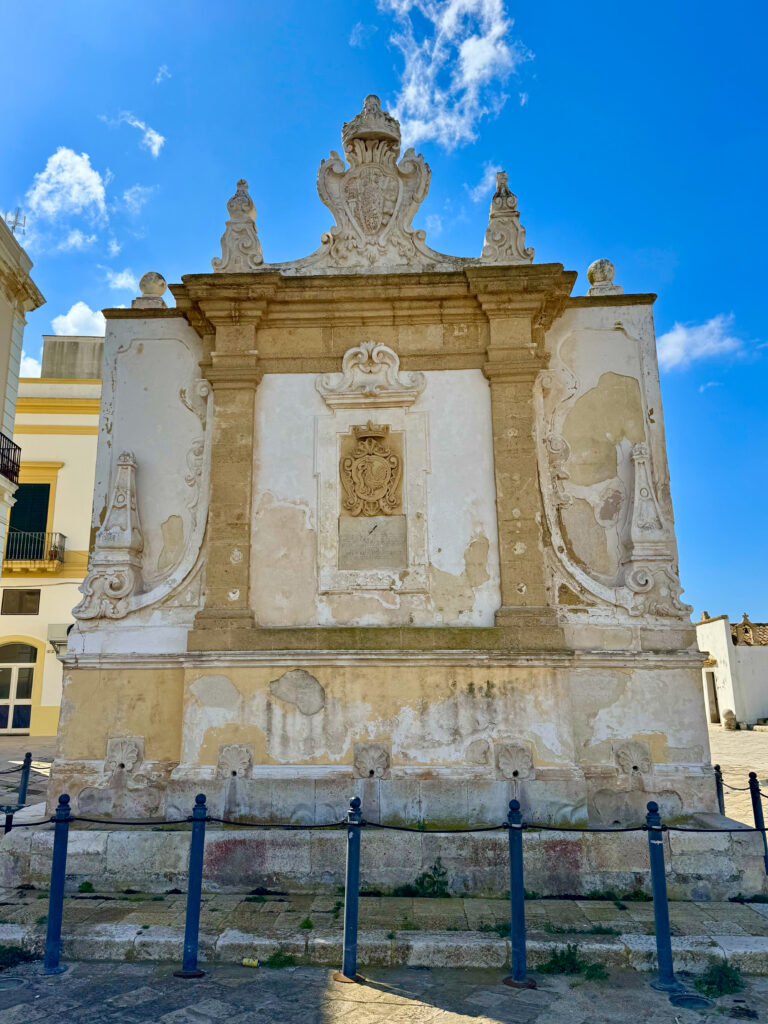
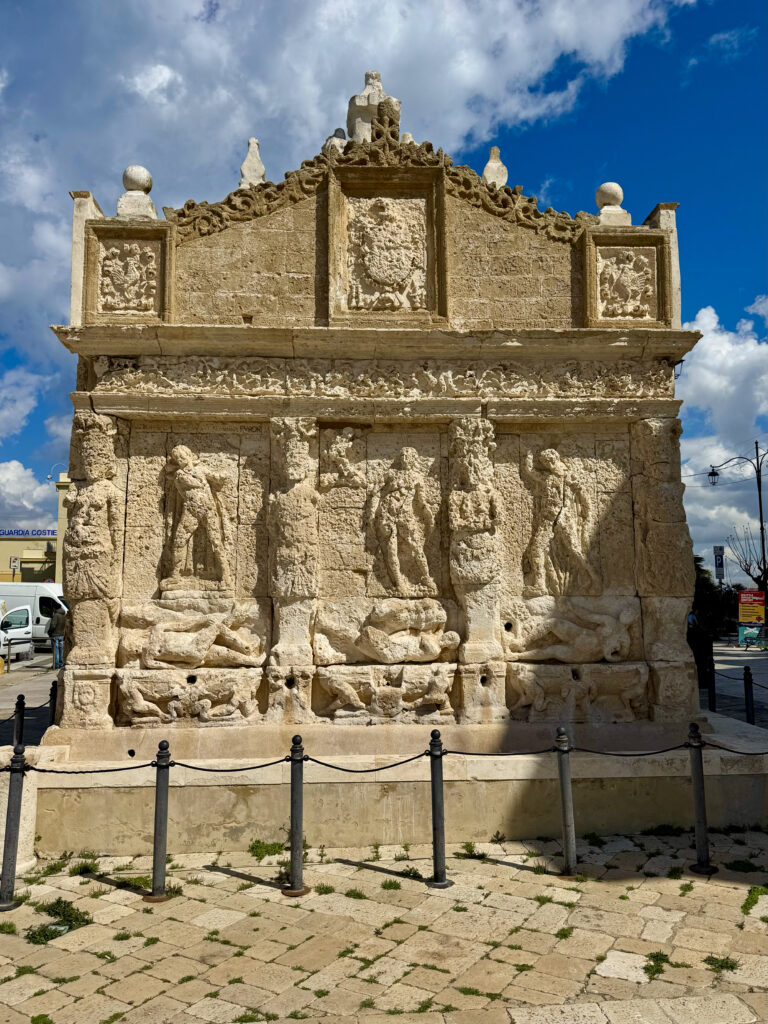
Leaving behind the modern high-rise buildings that contrast sharply with the historic skyline, the journey begins at Piazza Fontana Greca. This picturesque square is home to the Fontana Greca, a stunning fountain adorned with classical-era bas-reliefs depicting legendary scenes, later framed by a Baroque structure in the 16th century.
At the end of the Piazza Aldo Moro lies the Santuario di Santa Maria del Canneto church, a 17th-century reconstruction of an earlier sacred building. The church’s porticoed façade and three-naved interior reflect the evolving religious and architectural history of the area. The surrounding waterfront, still lively with fishing activities, adds a dynamic atmosphere to this historical setting.
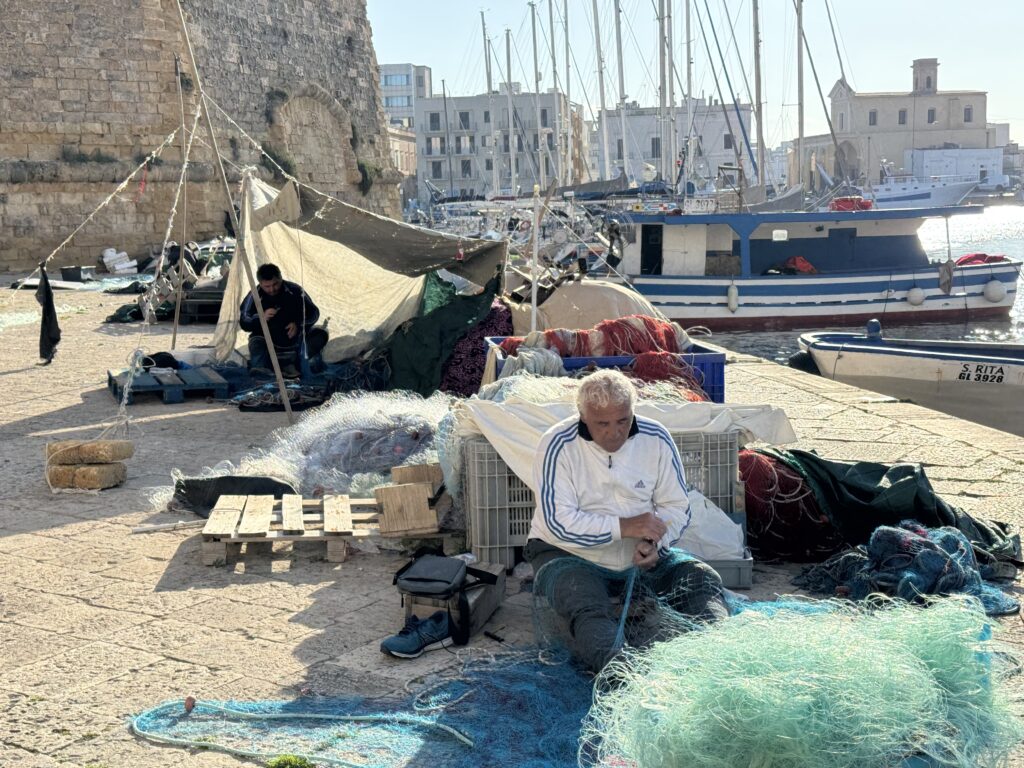
The Castle and Piazza della Repubblica
Head back to and cross the Ponte Papa Giovanni Paolo II, where the imposing structure of the Rivellino pier and fortified tower (built immediately after the castle) and the Castello di Gallipoli dominate the view. The tower, once equipped with catapults and cannons, served both as an advanced bastion for the defence of the city against sieges and as a control point for traffic between the mainland and the village.
The castle remains an important symbol of Gallipoli’s military past. Historically, its moat separated the fortress from the settlement, but it was filled in during the late 19th century to accommodate a marketplace.
Head into the old town along Via Antonietta de Pace, the main thoroughfare. This passes by Piazza della Repubblica, where the historic Arco Palace forms an elegant backdrop. Continuing along Antonietta de Pace (named after a local heroine of the Risorgimento movement) you will pass by on the left the Monticola and Ravenna buildings, with their stately, classical entrance along Via Fontò.
Palazzo Balsamo and the Civic Theatre
Continuing along the thoroughfare takes you to Palazzo Balsamo on the right (1718) with its striking façade punctuated by elegant stone-framed windows, though its upper section remains incomplete. Within the same block, accessible from Via Garibaldi, stands the Teatro Garibaldi civic theatre, built in 1825 on the site of a former courtyard.
Piazza del Duomo and the Cathedral
Further along Via Antoionette de Pace brings visitors to Via Duomo. The 18th-century clock tower marks the entrance to this historic precinct. At the far end stands the 16th-century Pirelli Palace, notable for its grand entrance and balcony-loggia adorned with a bifora arch. The spectacular façade of the Basilica Cattedrale di Sant’Agata rises up opposite.
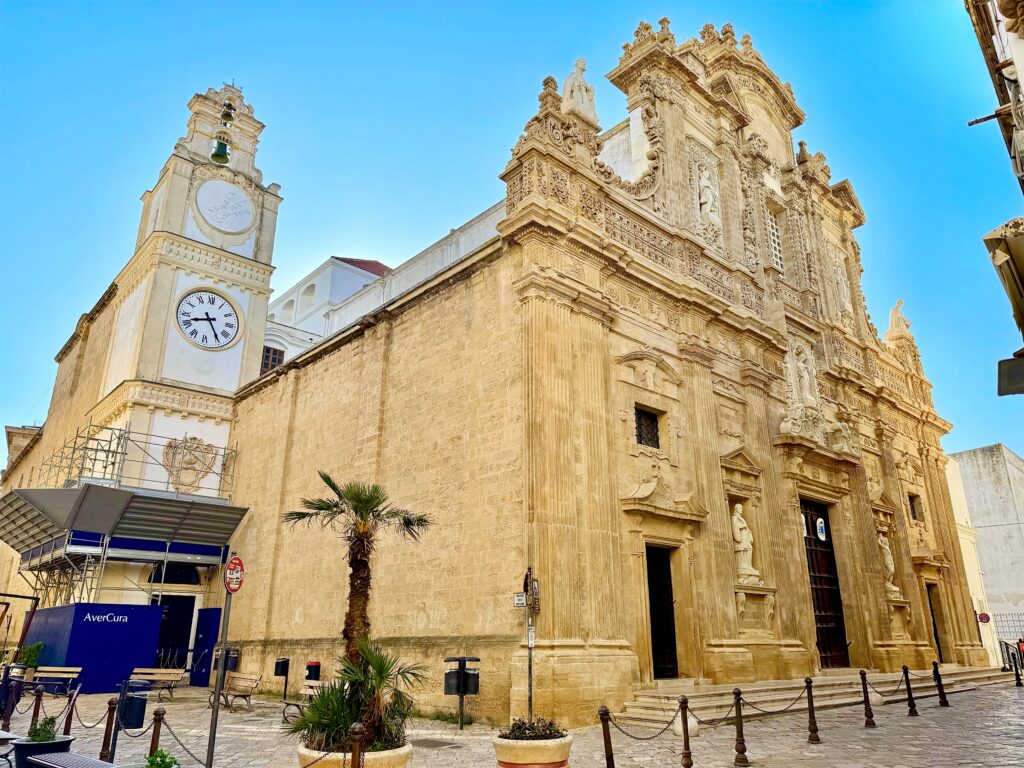
Construction
Constructed began in 1629 and 1696 under the patronage of Spanish Bishop Consalvo de Rueda, using materials sourced from nearby quarries, the cathedral’s design is attributed to Gallipoli architect Bernardino Genuino. Genuino, who passed away in 1653 or 1655, did not live to see his vision realised. It was not until 1667 that a new contract was awarded to master builder Tomaso Sanasi, leading to further structural developments, including the new sacristy. The cathedral was finally completed between 1683 and 1696, featuring a significantly larger structure compared to its predecessor, with a redesigned facade that departed from the original Romanesque-Pugliese style.
The exterior contrasts a rigorous lower section with an exuberant Baroque upper structure. Inside, the Latin cross layout, vaulted ceilings, and richly decorated chapels frame an overwhelming pictorial programme. Dominating the walls and ceiling are masterful works by Coppola, including The Assumption, The Souls of Purgatory, and The Martyrdom of Saint Agatha. These frescoes influenced later commissions, such as those by Neapolitan painters Nicola and Carlo Malinconico.
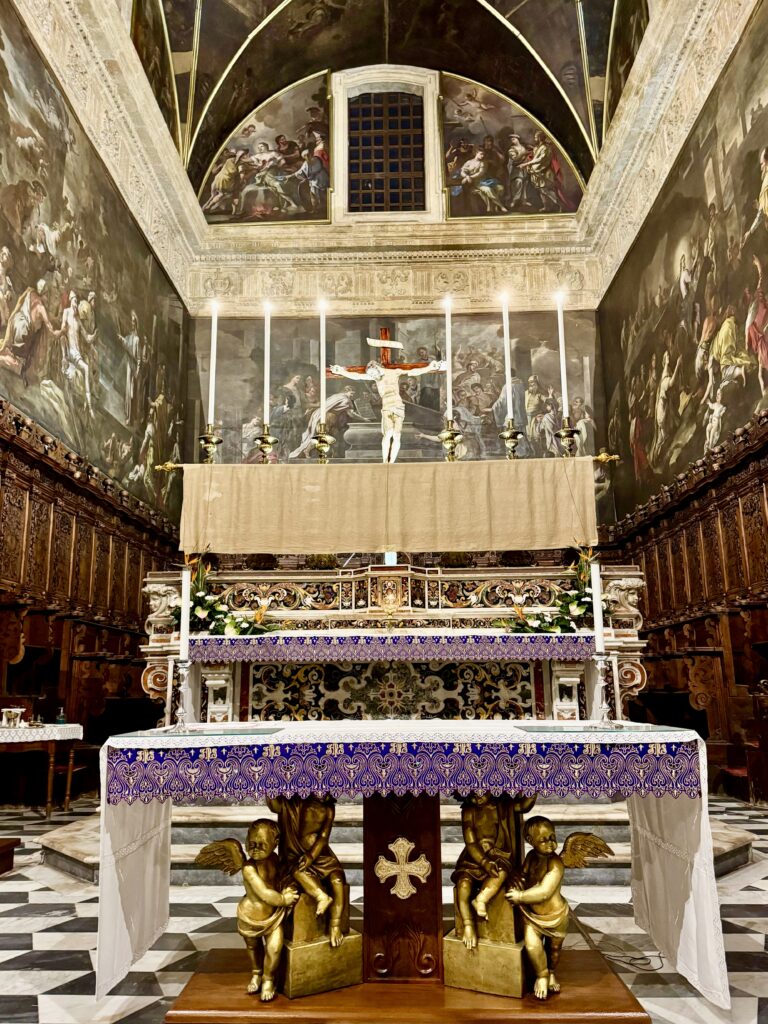
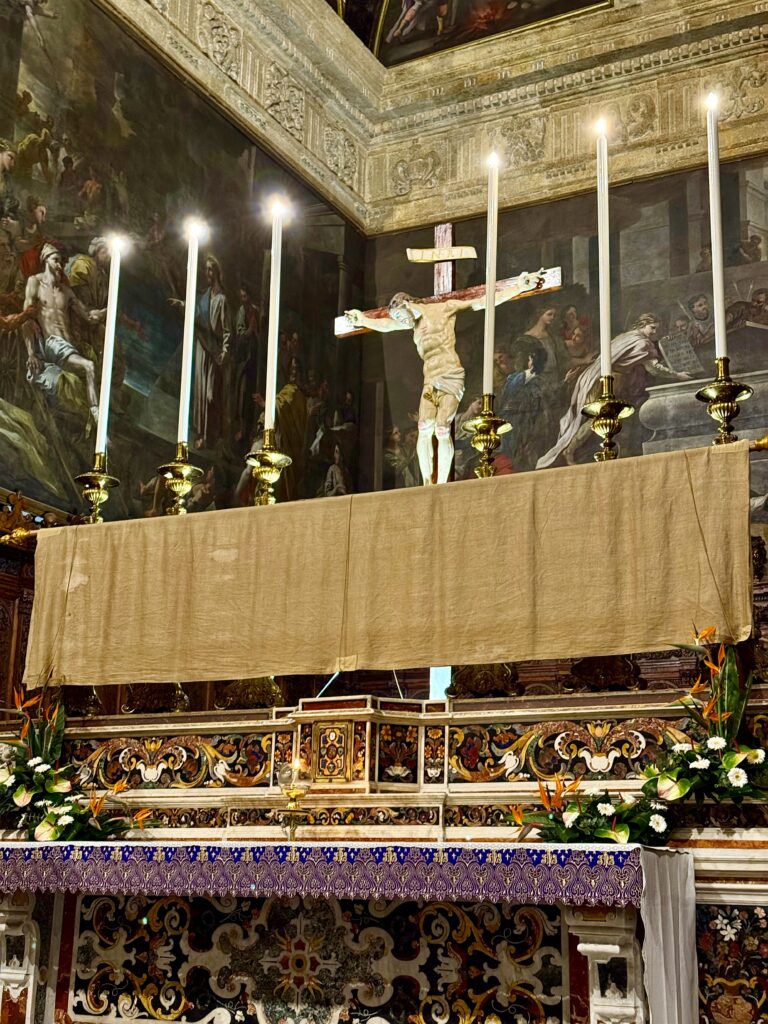
Inside in detail
The main nave, flanked by two smaller naves, extends up to the high altar and choir, with access provided by three steps leading to a central entrance and two lateral doors. The nave is supported by twelve Doric columns arranged in a specific pattern, providing the base for finely decorated round arches. Above these structures, large windows allow for cross-lighting, enhancing the cathedral’s grandeur.
The cathedral’s interior is adorned with intricate decorations, including rosettes, floral motifs, and elegantly designed altars dedicated to various saints. Key altars include those of St. Isidorus, St. Francis of Paola, Our Lady of Grace, St. Agatha, and St. Sebastian, among others. The altar of St. Agatha is particularly noteworthy, positioned in the left transept, while the high altar and bishop’s chair dominate the raised presbytery area.
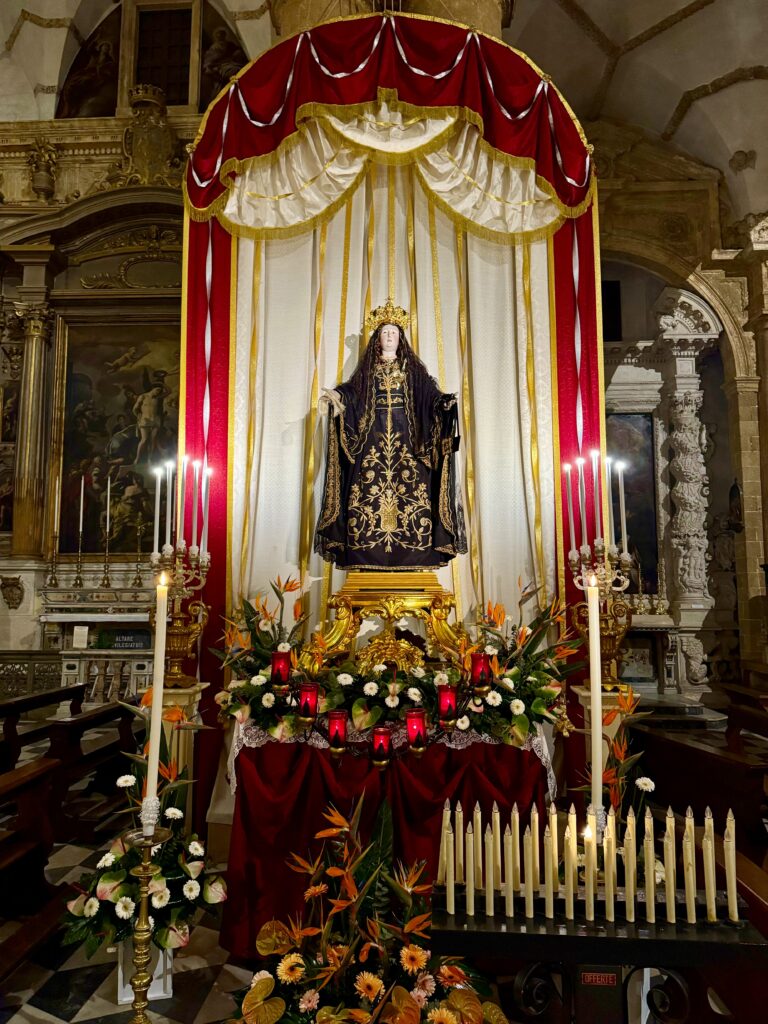
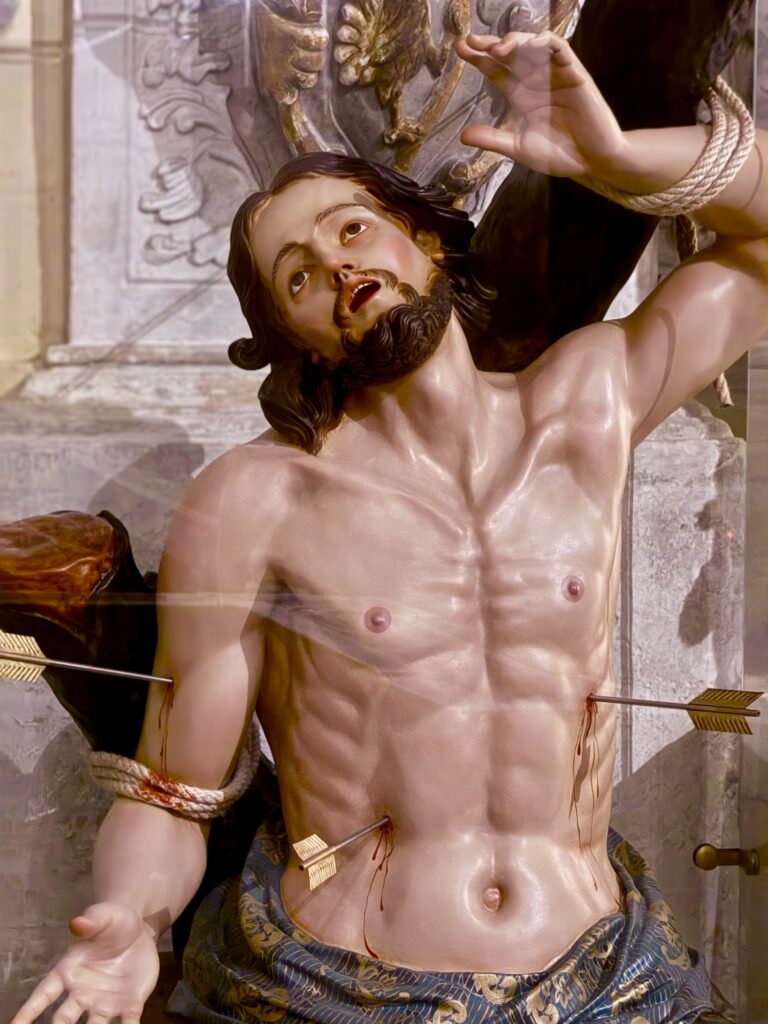
The cathedral’s roof structure is supported by trusses and covered by an elaborately decorated wooden ceiling featuring paintings. The two side naves, lower than the central nave, have cross vaults adorned with floral festoons and rosettes. The transept sections boast composite cross vaults that integrate harmoniously with the rest of the architectural design.
The central dome, rising above the Latin cross intersection, is a defining feature. Supported by four large round arches, it is adorned with metopes, a serrated cornice, and oval windows that allow natural light to filter through. The entire structure culminates in a magnificent wooden ceiling embedded with a large square canvas.
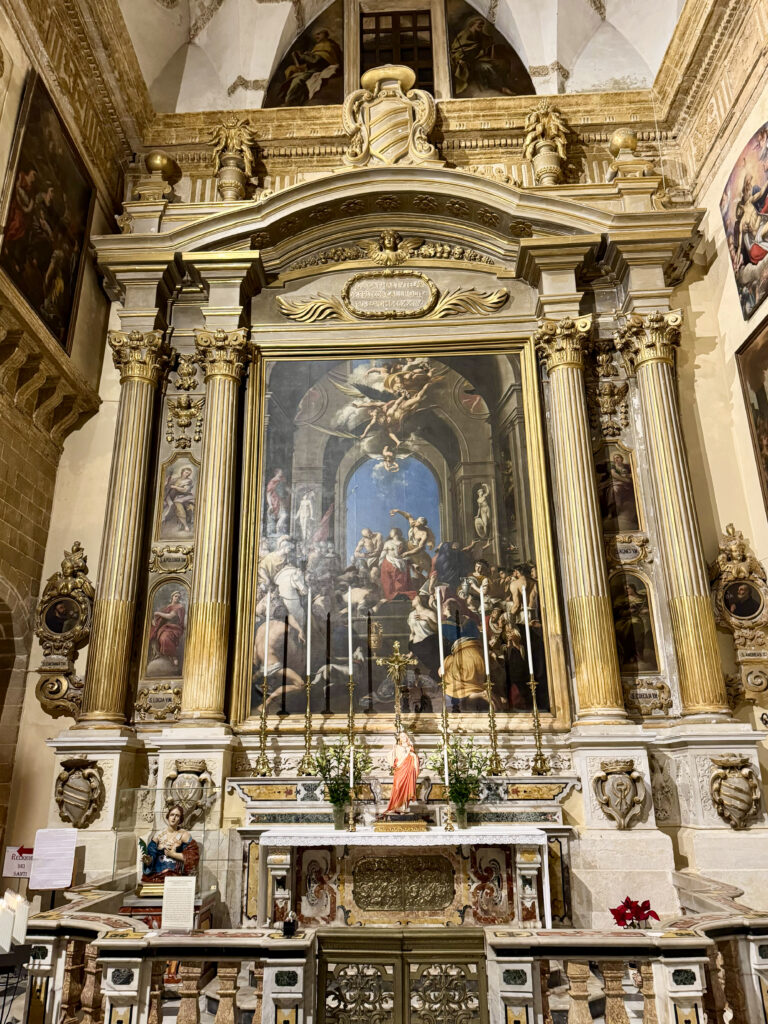
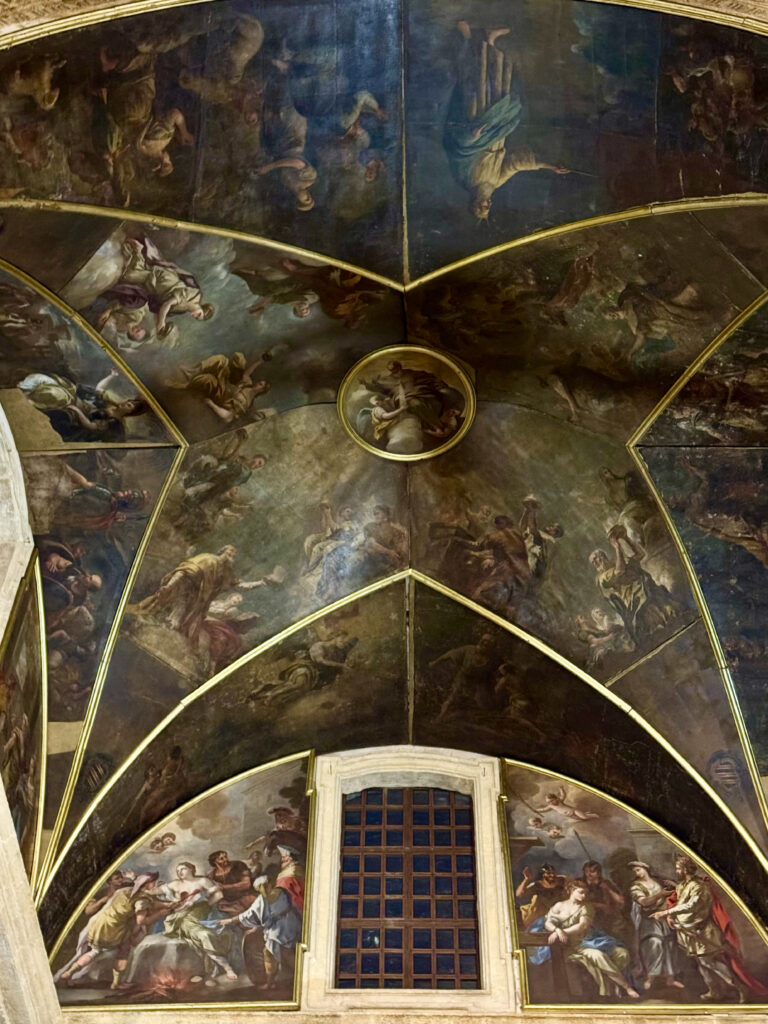
Final Stops: Civic Museum and Hidden Treasures
Leaving the cathedral, the walk continues along Via Antonietta de Pace, passing the Museo Civico Emanuele Barba on the right and the Frantoio Ipogeo di Palazzo Granafei on the left. Established in the 19th century, the museum houses an eclectic collection spanning malacology, numismatics, ceramics, period costumes, and iconographic documents that illustrate the city’s historical evolution.
Continue to the Chiesa di San Francesco D’Assisi, taking you out to the other send of the old town, where you can promenade along Riviera Nazario Sauro along the spiaggia della Purità. You can enjoy some refreshments at il Lanternino, enjoying the view over the beach and out to sea.
The Puglia Podcast
Also available on Apple Podcasts and Spotify, or wherever you get your podcasts from.
More Puglia | where is the best base for your vacation in Puglia?

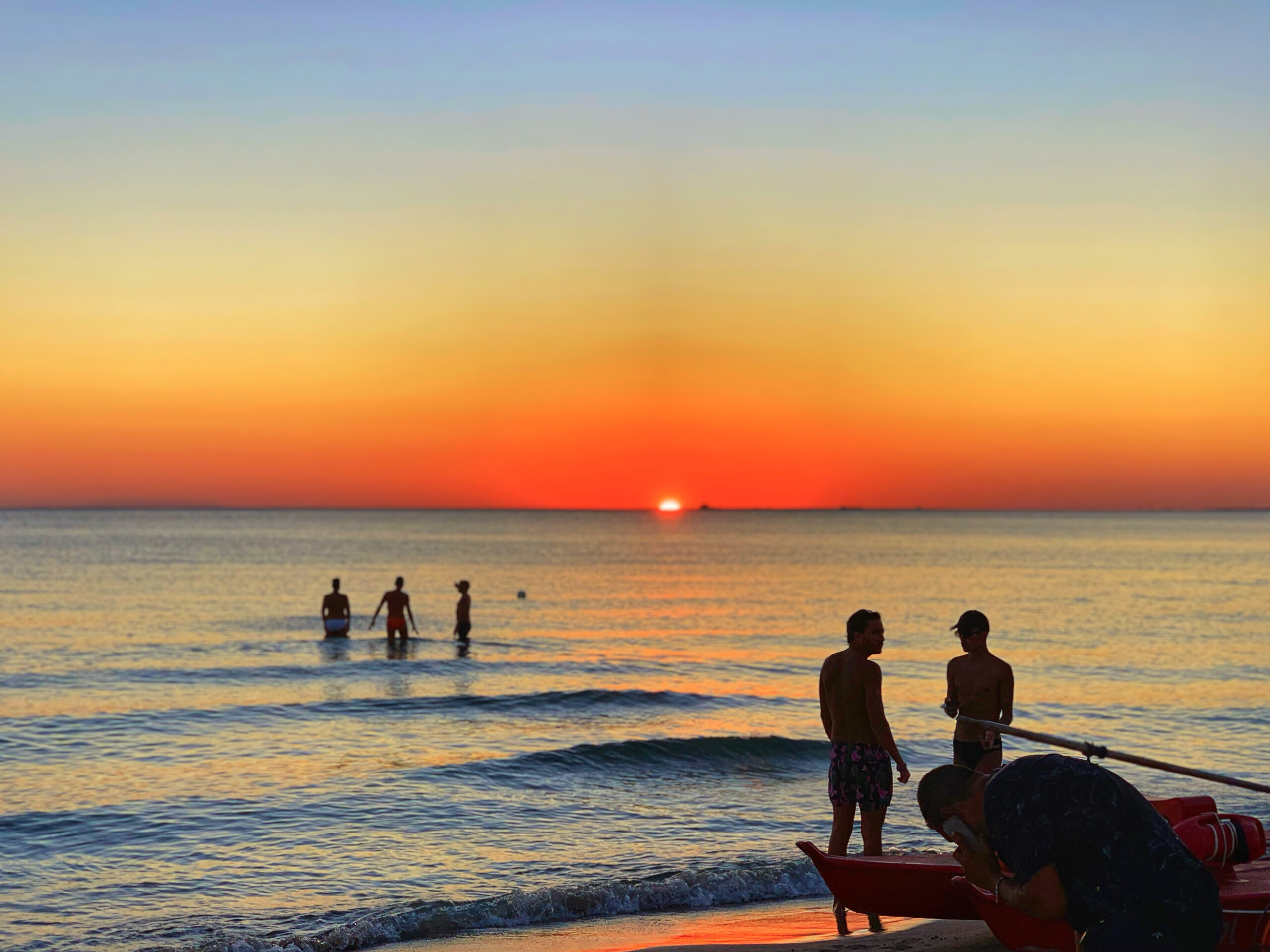
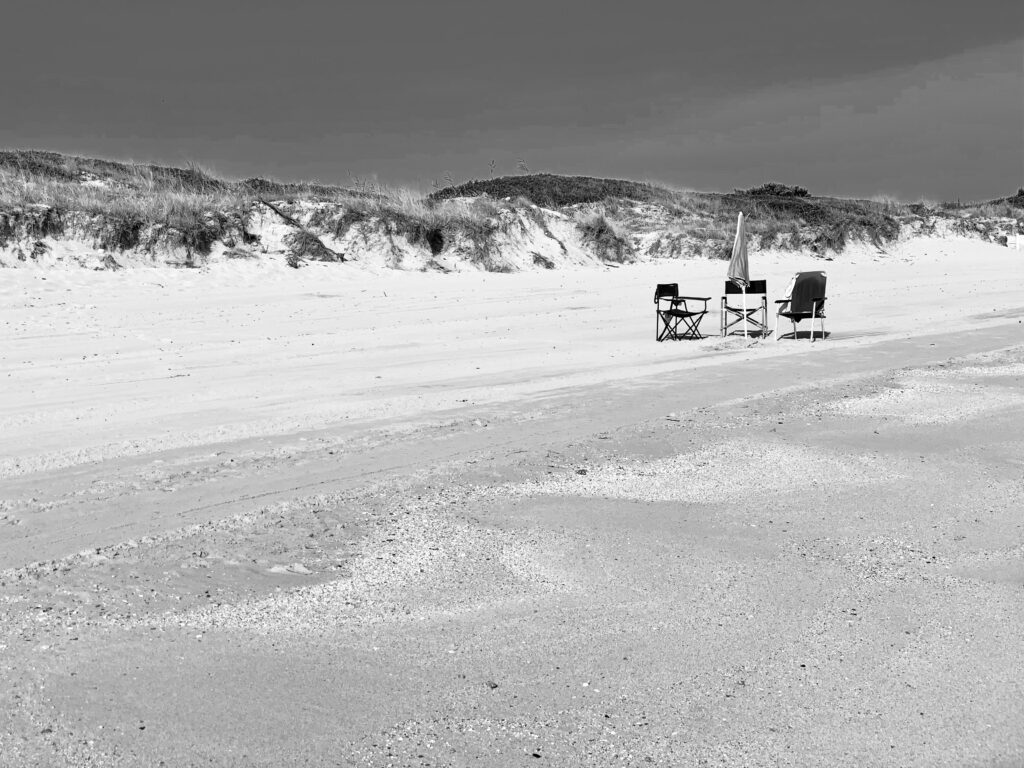
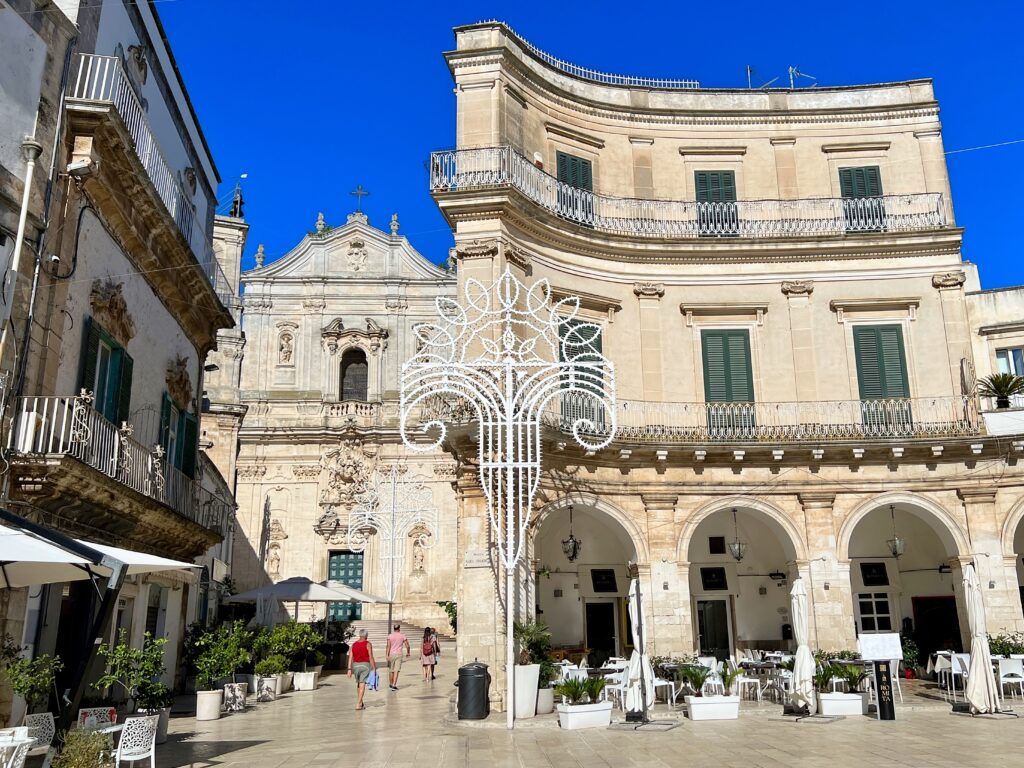
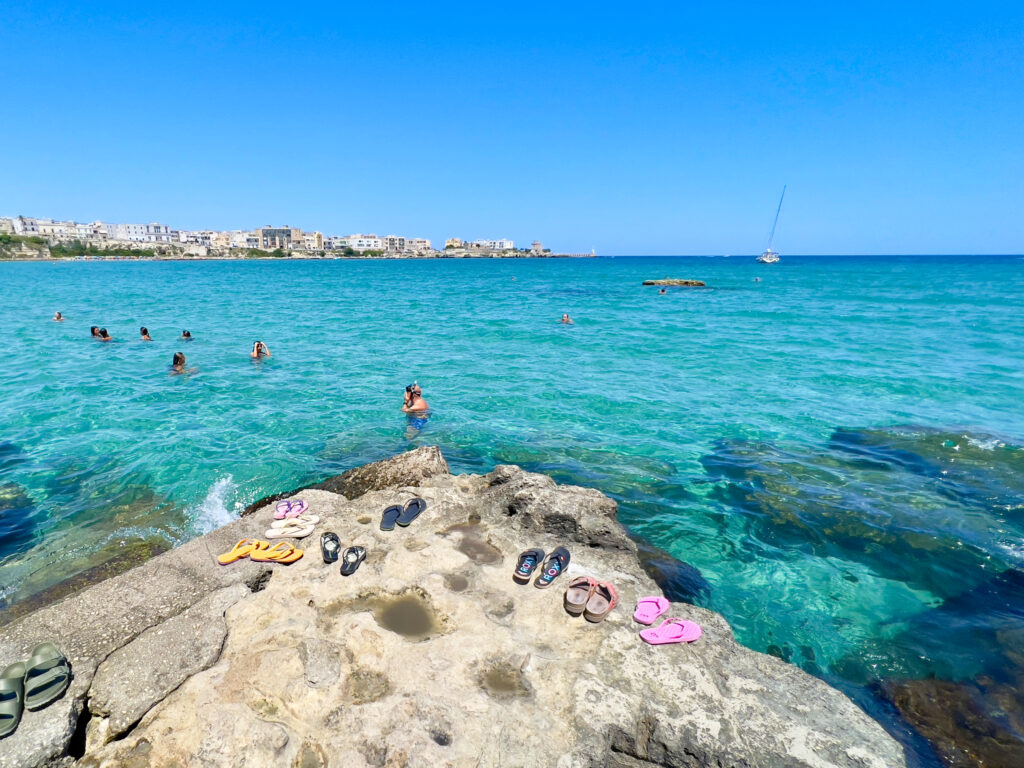
First- you two are outstanding. Endless gratitude for the work you’ve done with this site. It’s easily the most helpful regional travel information I’ve ever come across anywhere. And, I’ve looked. We are heading to Puglia the last full week of September. I know we will opt for a trulli for one half and beach for the other. I think I can manage the country decision, but I’m torn on the beach decision. I was originally set on Vieste as we are big into nature and small towns. HOWEVER… we are coming down from 4 nights in the Dolomites and I think we may be in need of more culture and town and maybe less nature by that point. So now I’m leaning towards Gallipoli. We will hire a car and the airport will depend on the beach decision. My slight concern is that we are not big nightlife/party people. Will Gallipoli be too much” for us? (We are not boring or prudish and I can day drink like it’s my job. It’s just that come 10:00…ok, ok …9:00… I turn 8 to a pumpkin.) In your opinion, which do you think is a better choice for us, Vieste or Gallipoli?
Ciao Lauren.
1. Gargano is beautiful. Vieste is a good size, but as I think you have seen when we visited Peschici and then Vieste in the 2nd half of September it was starting to close down for the end of the season. Peschici is smaller, and I could understand that. Vieste was still a little more open, and we have to say that we did the most fantastic boat tour from Vieste around the coast of Gargano. So there will be life in Vieste.
Vieste will feel much bigger than Gallipoli with its long stretches of city beach. It has a small old town, but it feels less defined than Gallipoli’s old town.
Gargano can feel cut off from the rest of Puglia, but there is much to do and see there. To enjoy Gargano you should explore it a little. The best eating out experience when have had to date (overall experience) was at the Trabucco da Mimì just outside Peschici.
2. Gallipoli is only a “party” destination that draws young people for its nightlife and beach clubs at the very end of July and August. Only then. And the change is instant. Come the end of August, when Italy goes back to work after summer, the party crowd of young people have gone. The immediacy of the change is unbelievable. On the last working day of August the city beach will be packed. The first Monday after a huge contrast. It really does happen like that.
At all other times of the year (and even during the July/August vacation time, during the days) Gallipoli’s old town still feels like a small fishing village. In September you will find the sleepier version of Gallipoli, and while people can still party at the beach lidos at Baia Verde, but the old town itself goes back to its quieter version. September is the month that most foreign visitors come to Puglia, and many will visit Gallipoli, but it’s nowhere near the party central that we explain it is July/August. And certainly the last two weeks of September are quieter than the 1st two, something else to bear in mind.
Gallipoli’s old town feels much more defined and intimate. In many of Puglia’s larger cities, (Bari, Lecce, Taranto), when you are in the old town you can easily forget that around you is the new town. It’s the same with Gallipoli. To get to the old town you have to pass through the new, but you can just sequester yourself away there if you are happy to stay put!
We have two trips already organised for Gallipoli – one in April for a cycle trip, and another in May for updating our Gallipoli guide ahead of summer.
3. There is some amazing natural park around Nardò, about 16km from Gallipoli if you do want some nature while you are here. We did an amazing trek there some time ago. Although people enjoy bathing there we are not recommending it to you for that reason – only for the possibility of a day tip for a trek in nature!
4. About car hire, if you know that you are going to stay put in either town for the beach and local restaurant and bar life, that’s fine. But do check the options for getting there. Gallipoli has its train station – but it’s only served by local commuter trains. Sometimes getting there by bus from Lecce is easier than taking the train!
Hopefully that gives you the information that you need to make a decision. Thank you for the kind comments about the website. We put a lot of thought into thinking about Puglia from the visitors’ perspective. Feel free to spread the word on any travel forums you’ve been looking for information about Puglia on. It’s nice to be noticed!
Enjoy your trip to Italy. Plenty of great experiences and especially good food to look forward to.
Buone vacanze.
LuigiM.
Grazie mille! Just perfect. I think we will opt for Gallipoli this trip and save Vieste for next time. I will absolutely pass along your site to my traveling pals and will eagerly await your new recommendations from your May trip. Truly, you guys are absolute stars. 🙏🏼❤️
Hi, I will be in Puglia for 12 nights with my family of 5 (3 kids 11/13/15). We love the sea so are think of 3-4 nights in Gallipoli, 4-5 nights around Ostuni at a Masseria and cannot decide on the 3rd base. Would you recommend Monopoli or Otranto for the 3rd home base? Also, do you recommend to stay in the city center in Otranto, or at a Masseria that is not within walking distance to the city? Thank you, your advice is greatly appropriated!
Hi Giulia. We have three guides that contain the information to help you make this decision. Because we don’t know what your personal travel priorities are, the time of year and whether you will have your own transport, the articles try to anticipate which bases best suit certain criteria:
1. The Puglia Guys Guide to finding the best base for vacation in Puglia. Taking account of beach vs countryside, public transport vs vehicle hire and time of year. In August we would try to avoid city beaches because they will e extremely busy, but until June and from September it is a completely different experience. In August we would be looking for beaches out of town accessible by private transport.
2. The Puglia Guys Guide to Essential Puglia Day Trips and Road Trip Planning. This is a supplemental guide to the first one. If road trips are something you want to do our absolutely favourite road trip start is from Otranto down the Adriatic coastal route. It is a stunning drive with superb seascapes all along the way. Santa Cesarea Terme, Castro Marina, Cala dell’Acquaviva, Tricase Porto, Marina Serra, il Ciolo and Santa Maria di Leuca. Likewise just north of Otranto you have Torre Sant’Andrea, Torre dell’Orso, Grotta della Poesia. But if you just want stunning, sandy beaches, without the stunning geography then the Ionian coast south of Gallipoli might suit you better.
3. For that reason, take a look also at the Puglia Guys Guide to 50 of Puglia’s best beaches.
One final thought. If your main aim is relaxing on beach, then think about Vieste in Gargano. Our Vieste guide explains why for city beaches, and remote beaches, and also for countryside, Gargano is hard to beat. Here are long stretches of sandy beach, up to 3km long, accessible from the centre of town. But Gargano is itself 2 hours from Bari and whilst there is plenty to do in and around Gargano, and again, some of the best beaches in Puglia, it does mean Salento and the Valle d’Itria if you want to visit popular destinations like Polignano a Mare, Alberobello are away. But instead of splitting 12 nights over the 3 destinations mentioned, you could add a bit more distance between them and consider Vieste, then head south for the rest of your vacation.
Buone vacanze. LuigiM.
Ciao. Heading to Gallipoli in Aug for 3 nights over Feragosto, 1st time visitors on honeymoon, interested in both Baia Verde and old town not sure where the best area to stay in? Will need to park a car as well. Then off to either Ostuni or Monopoli (still can’t decide best base) for 3 nights. We love the beach but also want to experience all the touristy areas too. Any help would be great, Grazie Mx
Ciao. Baia Verde is pretty soulless, especially compared with Gallipoli’s old town. It’s basically holiday homes and summer houses resort, right by the beach. You can eat there, the beach lido clubs are fun, though it is a beach resort with semi modern housing apartment blocks and no atmosphere. But the benefit is that you can walk to the great beaches. Gallipoli’s old town has the charm of an old town, has some city beaches though they will be jam packed – ferragosto is the height of the holiday season – and at that time of year the evening life is also on the busy side. But you can still soak up old town atmosphere during the day, and it has a wide choice of restaurants and charm. Baia Verde is 3km away. Parking around both will be challenging around ferragosto!! We think you would find Gallipoli’s old town more memorable for honeymoon, especially in the evening – and Baia Verde has no atmosphere in the evening. It’s a lively day beach resort destination. Most people would go into Gallipoli for dinner or night life. So, I suppose it comes down to that: Baia Verde for an easy walk to the beach, then at night drive into Gallipoli, then drive back after dinner. Or Gallipoli with a drive to Baia Verde in the morning and back in the evening. Though, as I said, Gallipoli does have city beaches.
For contrast maybe Ostuni would be better than Monopoli, in the sense that Monopoli is on the coast and is another busy beach destination, though more rocks than sand. Ostuni has a bit more green to it, for contrast. We take friends on a loop of Ostuni/Cisternino/Alberobello, Monopoli and Polignano a Mare from our Ostuni base. But you can do that the other way from Monopoli.
Take a look at our Monopoli city guide and Ostuni city guide. They list the nearby beaches. To find the better ones, it really is much of a muchness from either. One tip: if you can’t find the perfect accommodation in Ostuni, if you choose there, try nearby Carovigno. It is charming, perhaps with better value accommodation at that time of year and has good access to nearby beaches too! Buone vacanze!
Marco
Thank you so much, really appreciate the reply. We’ll go for the old town in Gallipoli – unless you suggest we stay further out if its going to be super busy and ill have a look at Carovigno too. Grazie 🙂
Ciao.
We took your advice and will stay in Ostuni as a base for our first 3 days, but we are thinking about heading south for our last few days. We are interested in checking out the Ionian coast. We understand that late April is not beach season but are wondering if going to Gallipoli or along the coast north or south of Gallipoli is a good idea. Or, are we better off staying in Ostuni and taking day trips?
Thanks
Mike
Ciao. I think Gallipoli is a fine choice for April. It is a great city, and popular, but in April it will still feel ‘local’, with some but not too many visitors. You certainly will be able to sit on the beach there when the sun shines, even in April. And it may well be ok to swim. Gallipoli is a good choice because of the nice, sandy city beaches, as you can see. La purità will not be busy in April. The old town is so pretty, and you are on the sea. The season starts after Easter, so there certainly will be plenty restaurants, bars and other places open. It will be good to have the contrast between Ostuni and Gallipoli in terms of countryside and coast.
From Gallipoli there is plenty to see too. Porto Selvaggio, Punta della Suina, and Lecce is very close. It’s a good choice for 2nd base!